Creating Charts
In the created dataset, you can select the type of chart you need to create based on your requirements. According to the requirements of different categories of charts, select dimension and measure fields, and the system will automatically generate the chart. HENGSHI SENSE supports sharing charts and collaborative applications among colleagues. For the charts under this application, you can use them directly or modify them before use.
Left Data Panel
Data
Select the created dataset and use the data from this dataset to create the required charts. Datasets that have established relationships will be connected by lines. 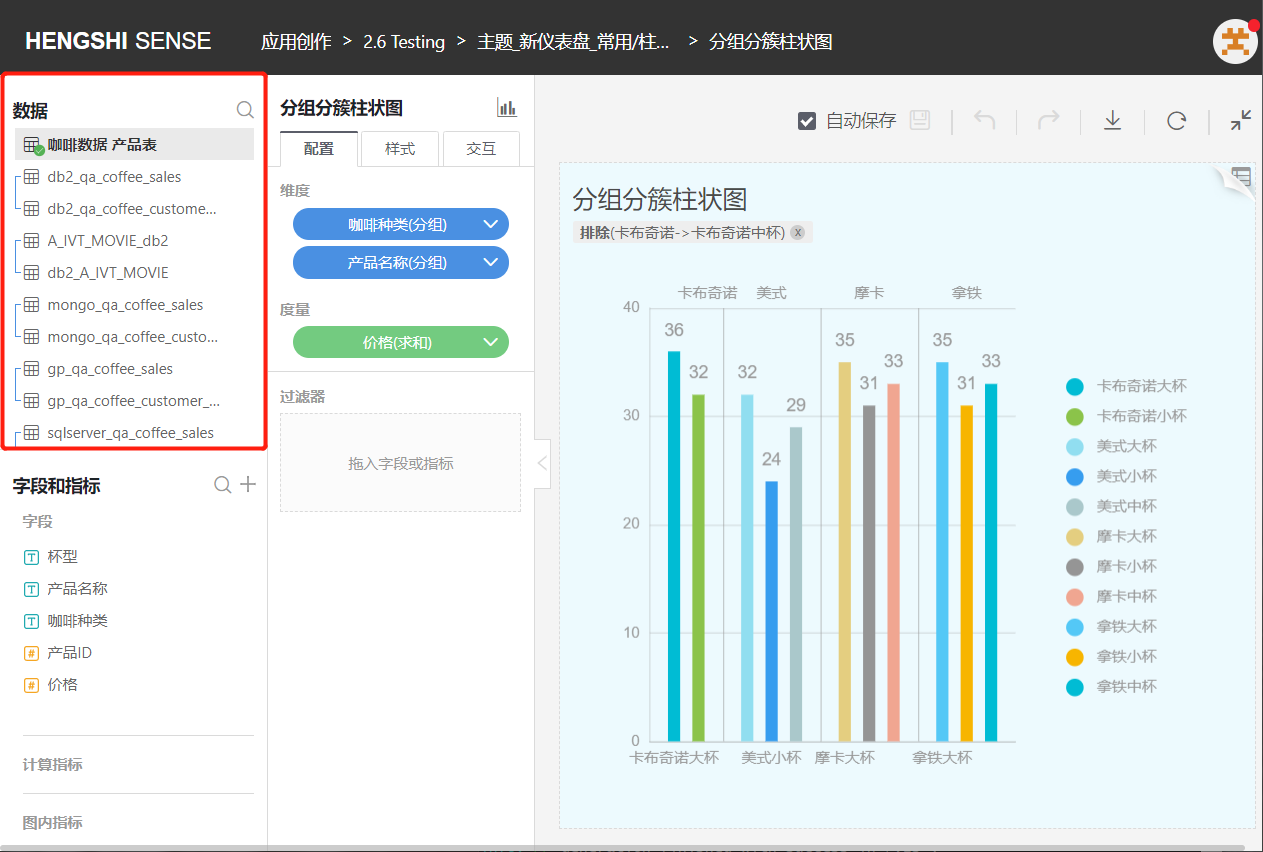
Click the Search icon on the right side of the dataset to directly navigate to the management page of that dataset. 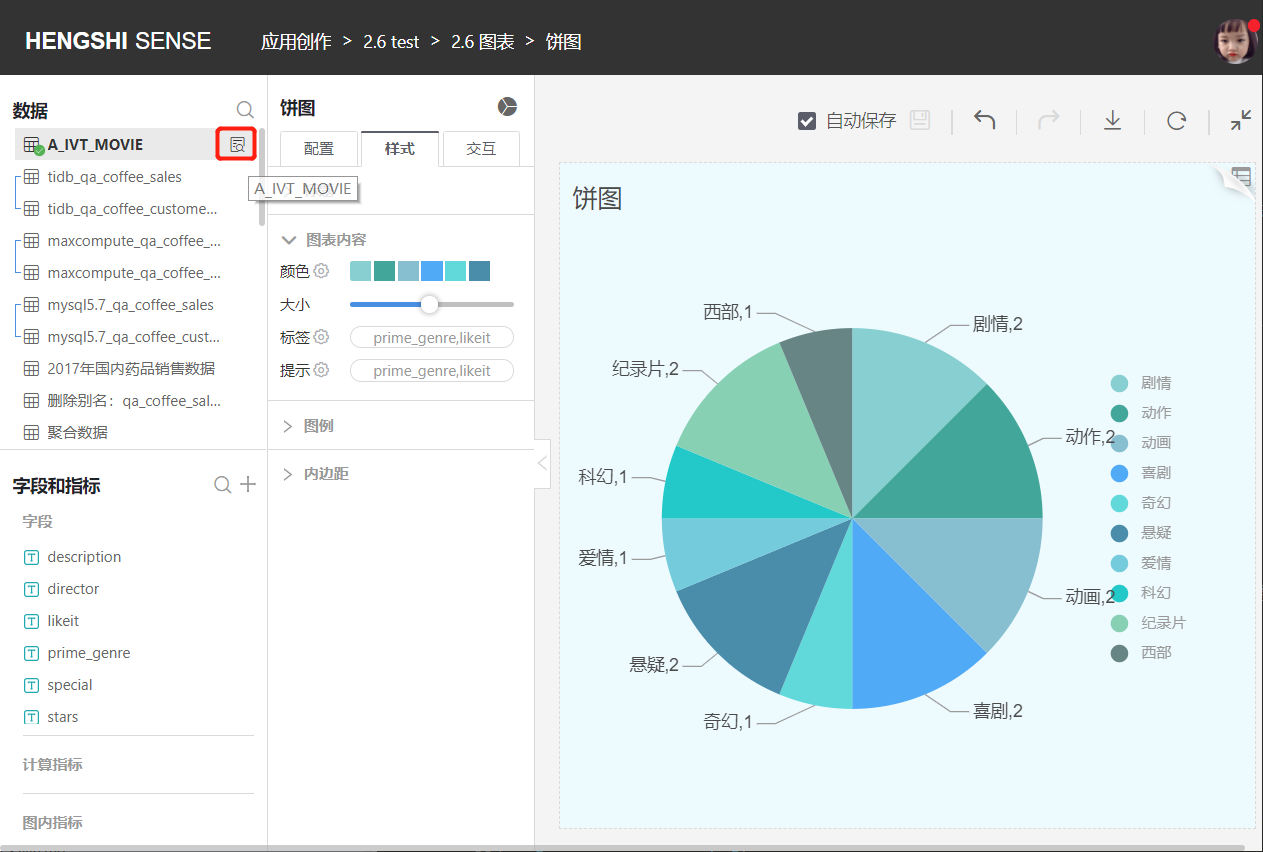
Fields and Metrics
Fields: All original fields and newly added fields in the current dataset. If the fields have grouping information, the grouping information will also be displayed in a tree structure in the field list for quick field location.
Calculated Metrics: All metrics newly added that depend on this dataset. The grouping information of the metrics will also be displayed in the metrics list.
In-chart Metrics: Dimensions and measure fields within the chart.
Drag fields to configure dimensions and measures. 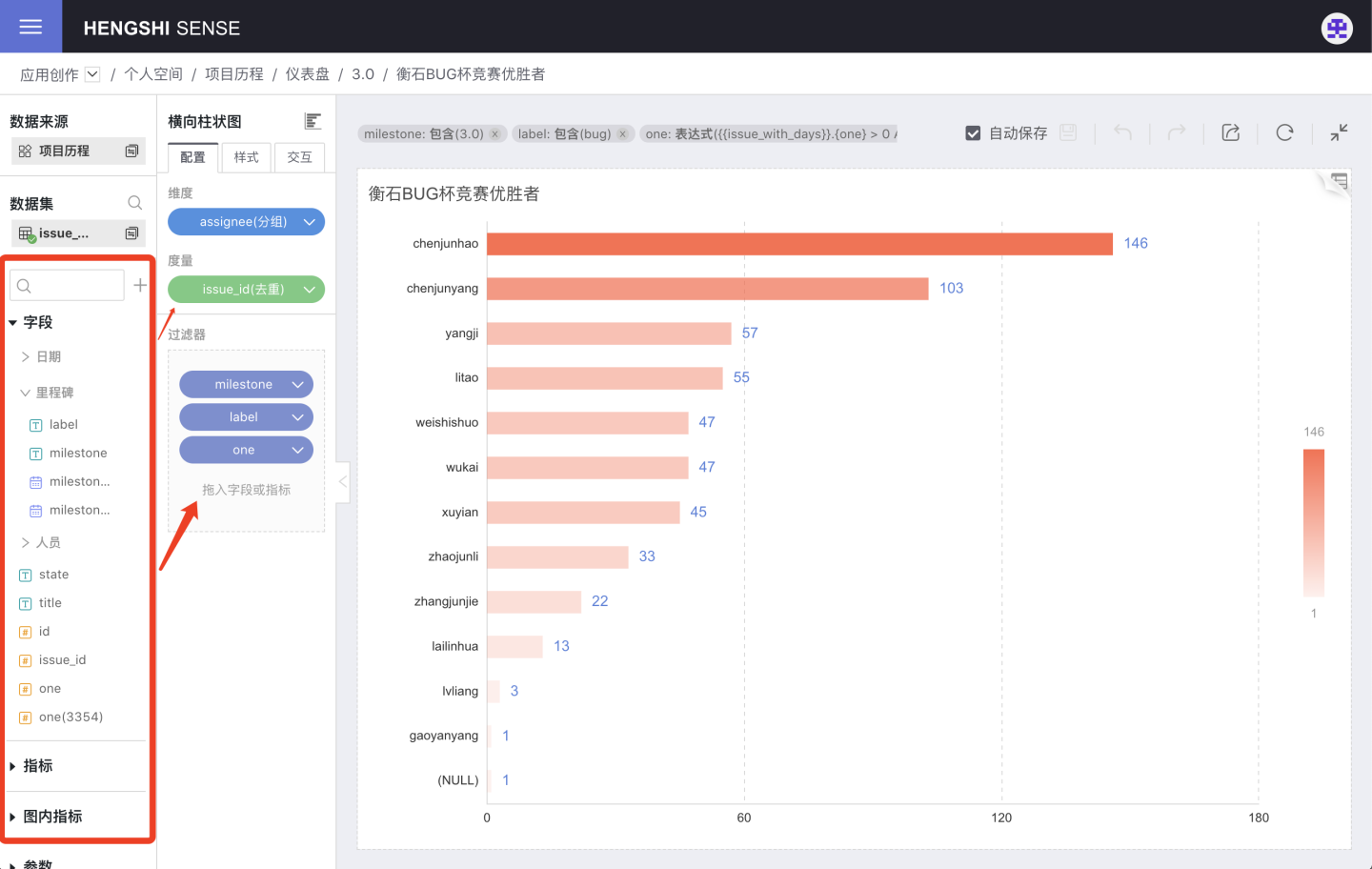
Create New Field
You can add fields of text, date, and number types by calculating column values, using advanced expressions, or grouping column values. 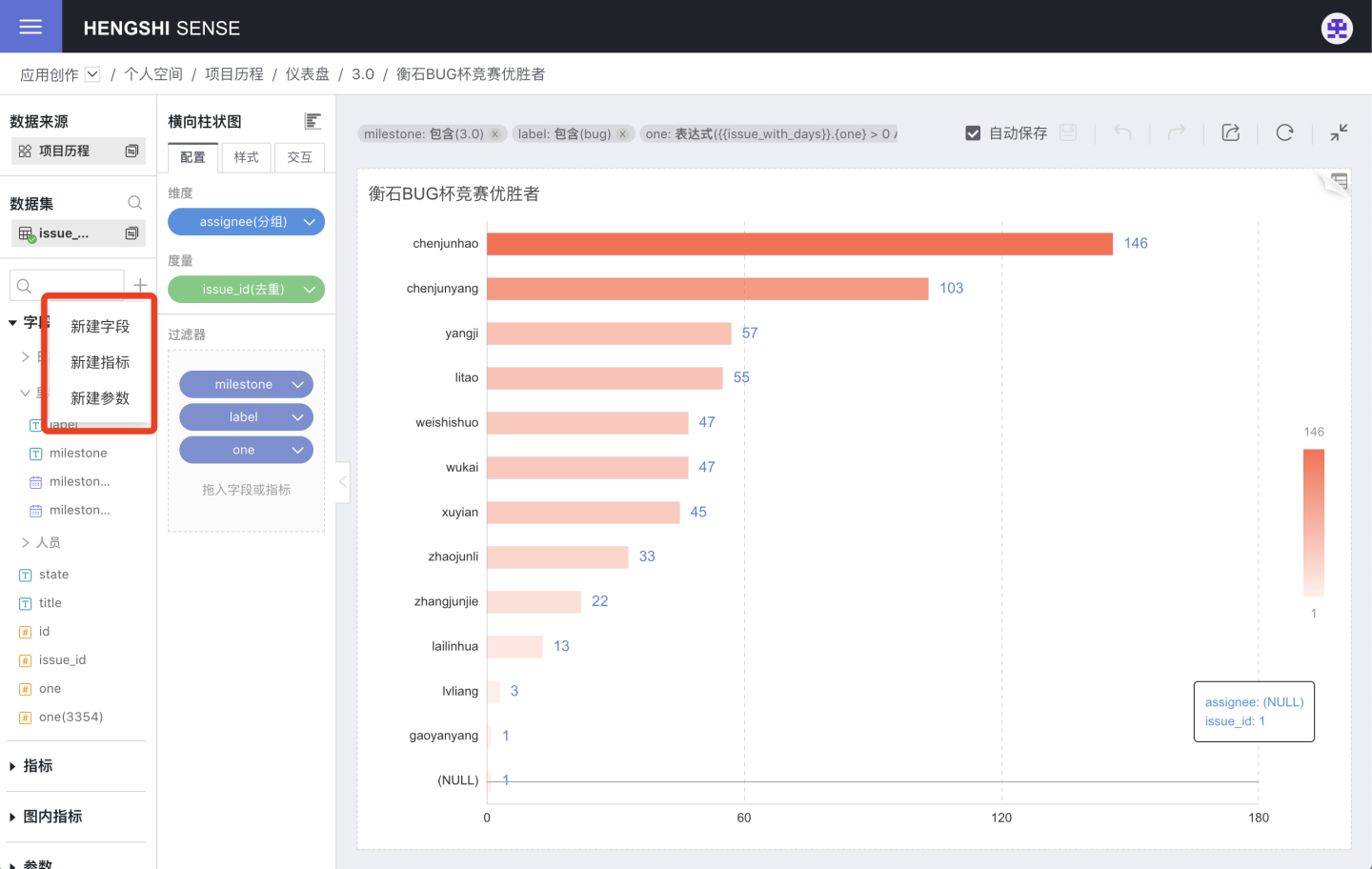
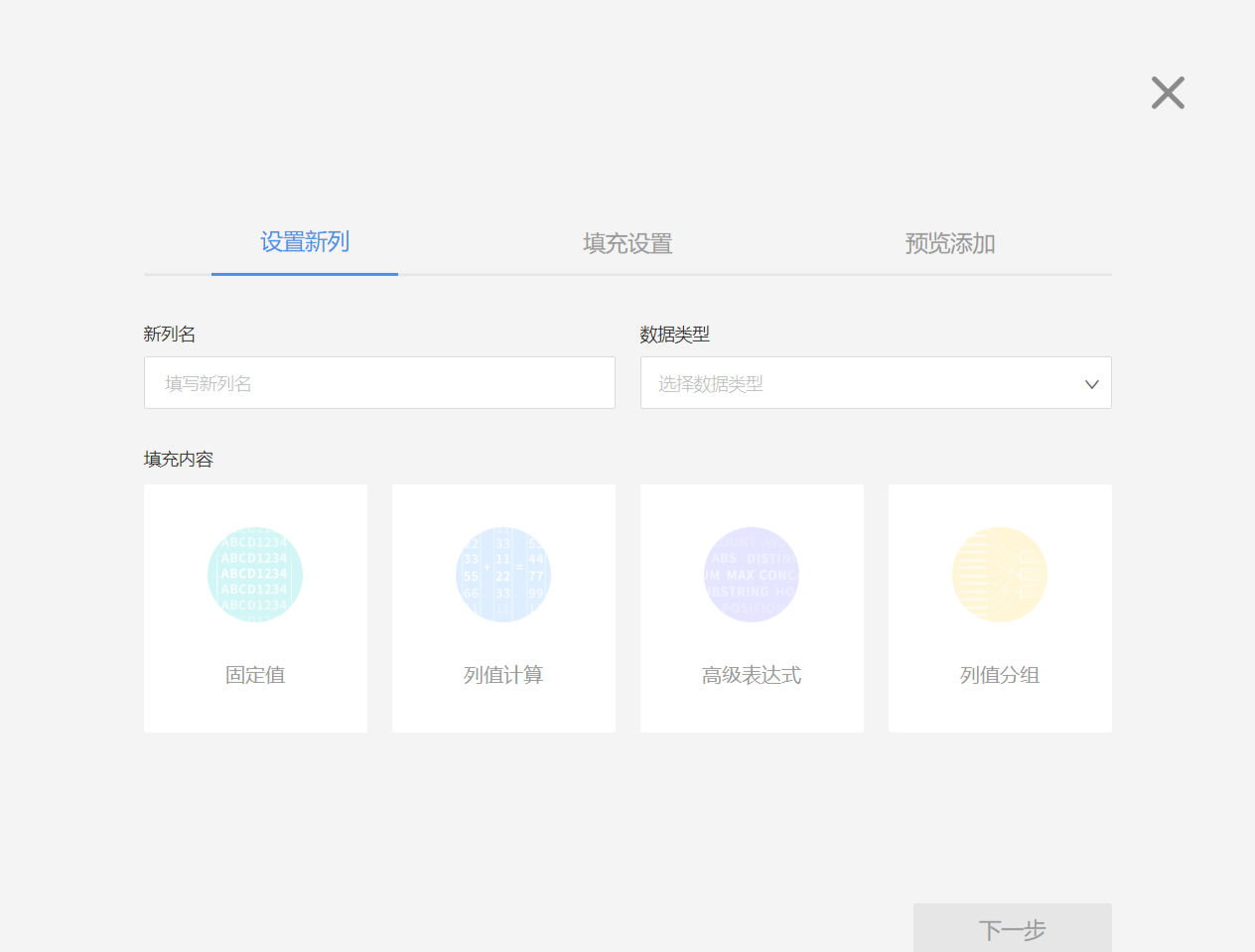
Create New Calculated Metrics
You can add fields of text, date, and numeric types by calculating column values, using advanced expressions, or grouping column values. Non-aggregate metrics are not allowed to be added. 
Create New Parameter
You can add parameters of text, number, date, and time types to achieve parameterized control of the application. 
Top Right Toolbar
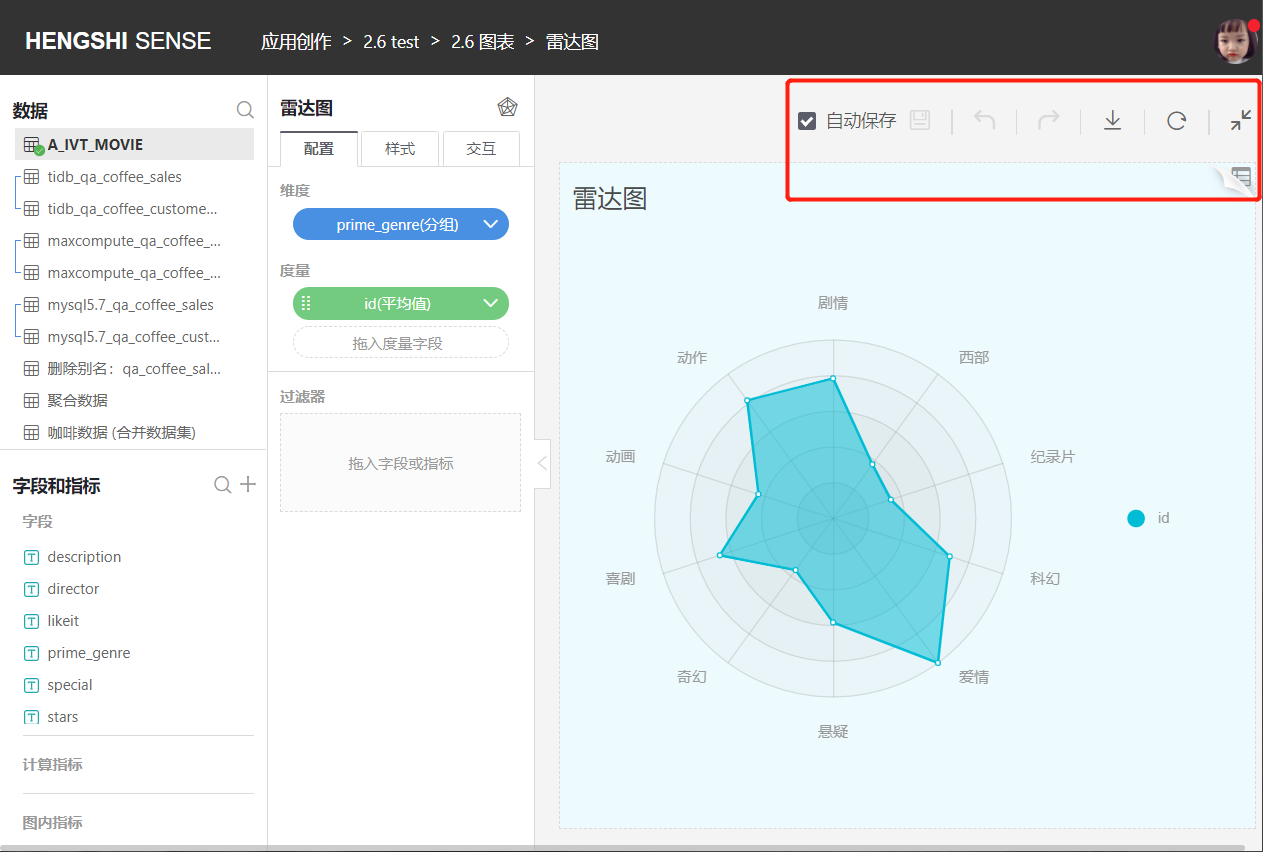
Auto Save
Undo and redo operations do not affect auto save.
By default, Auto Save is checked. If the user unchecks Auto Save, the page will not send requests each time the chart page is configured. Requests will only be sent when Auto Save is checked again or the Save button is clicked, at which point the chart will be re-rendered.
When Auto Save is unchecked:
- A pause overlay will appear on the chart interface;
- Users cannot edit fields/metrics;
- Any ongoing drill-down will be canceled;
- Any open detailed data pop-up windows will be closed.
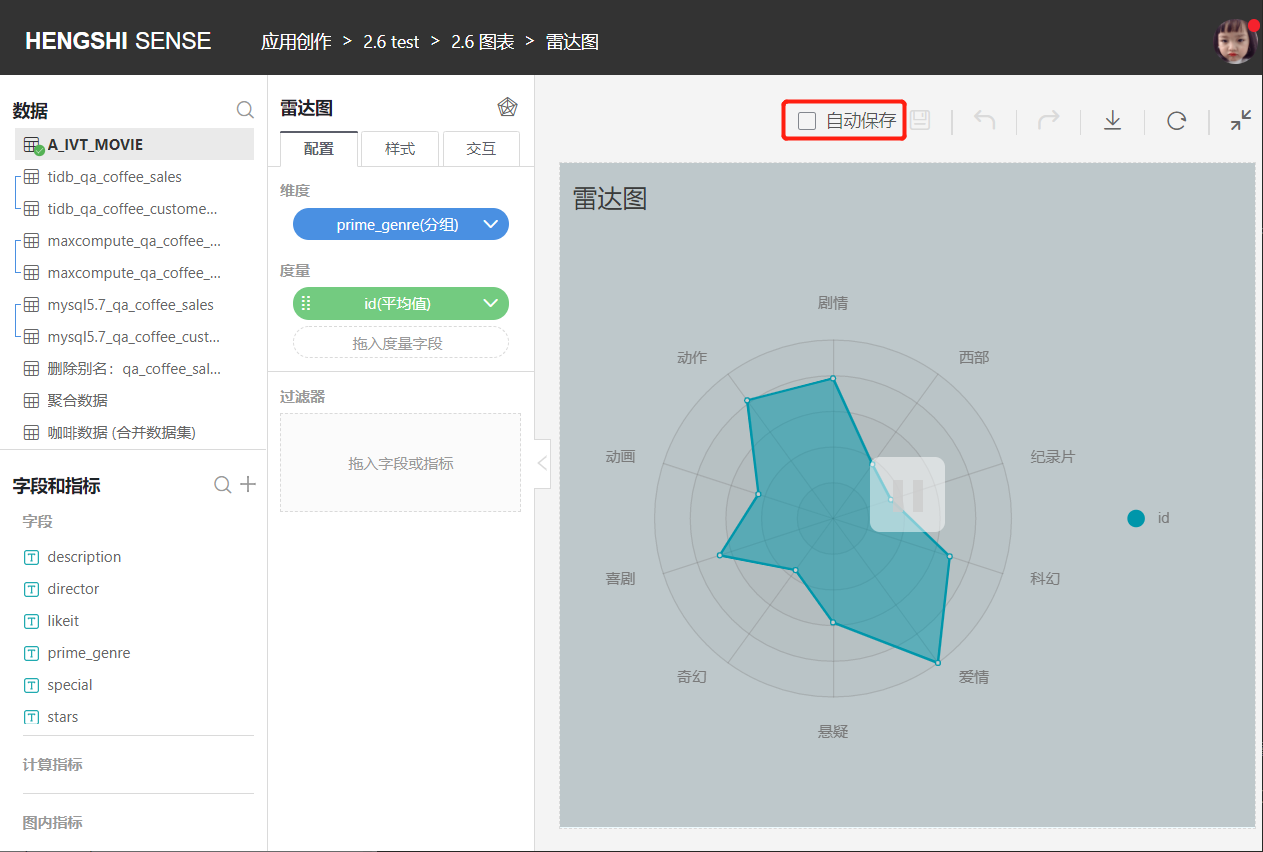
Save
When Auto Save is unchecked, users can click the Save button to save after performing operations on the chart. At this time, the pause overlay still exists, and the chart will reload. 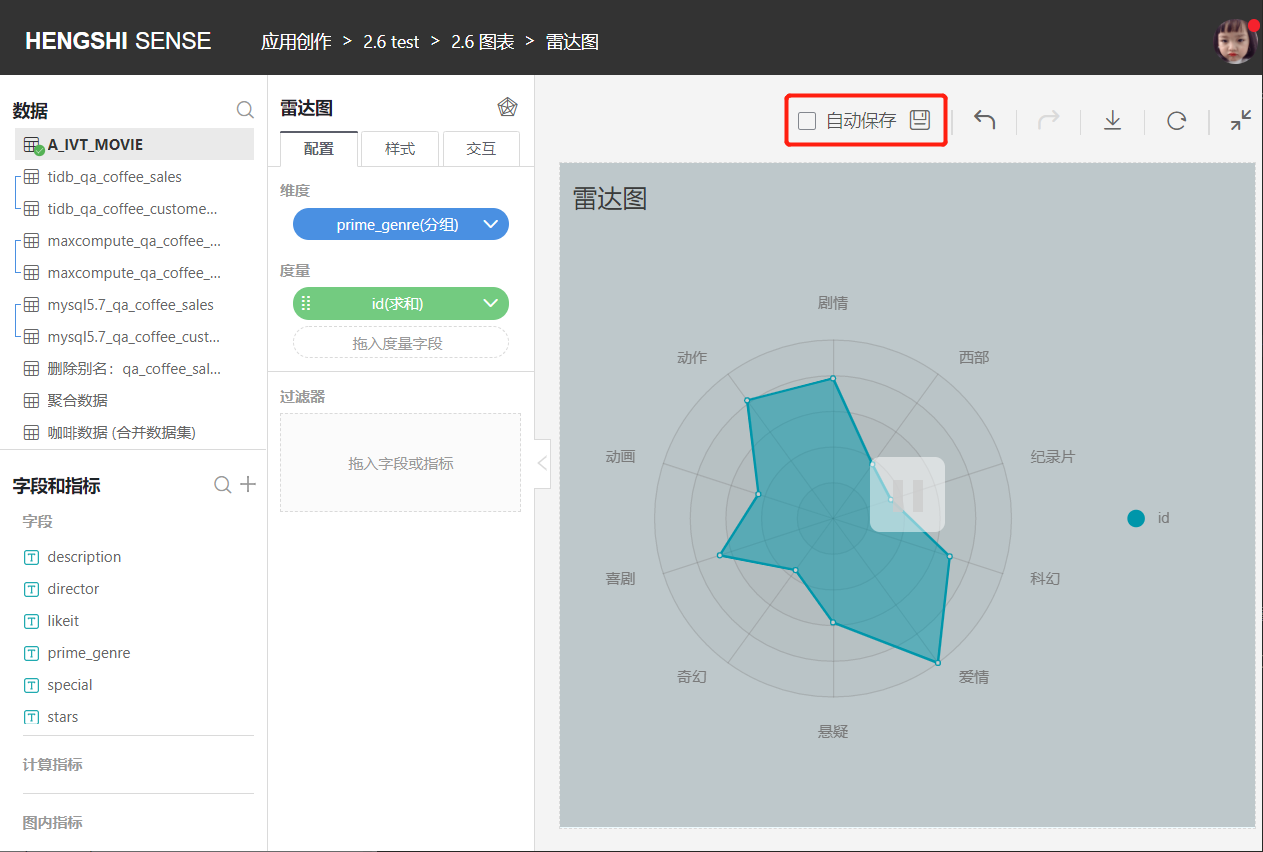
If the user does not click the Save button after performing operations on the chart and directly clicks the Refresh button or refreshes the page, a prompt will appear: "Your changes have not been saved. Are you sure you want to refresh?" 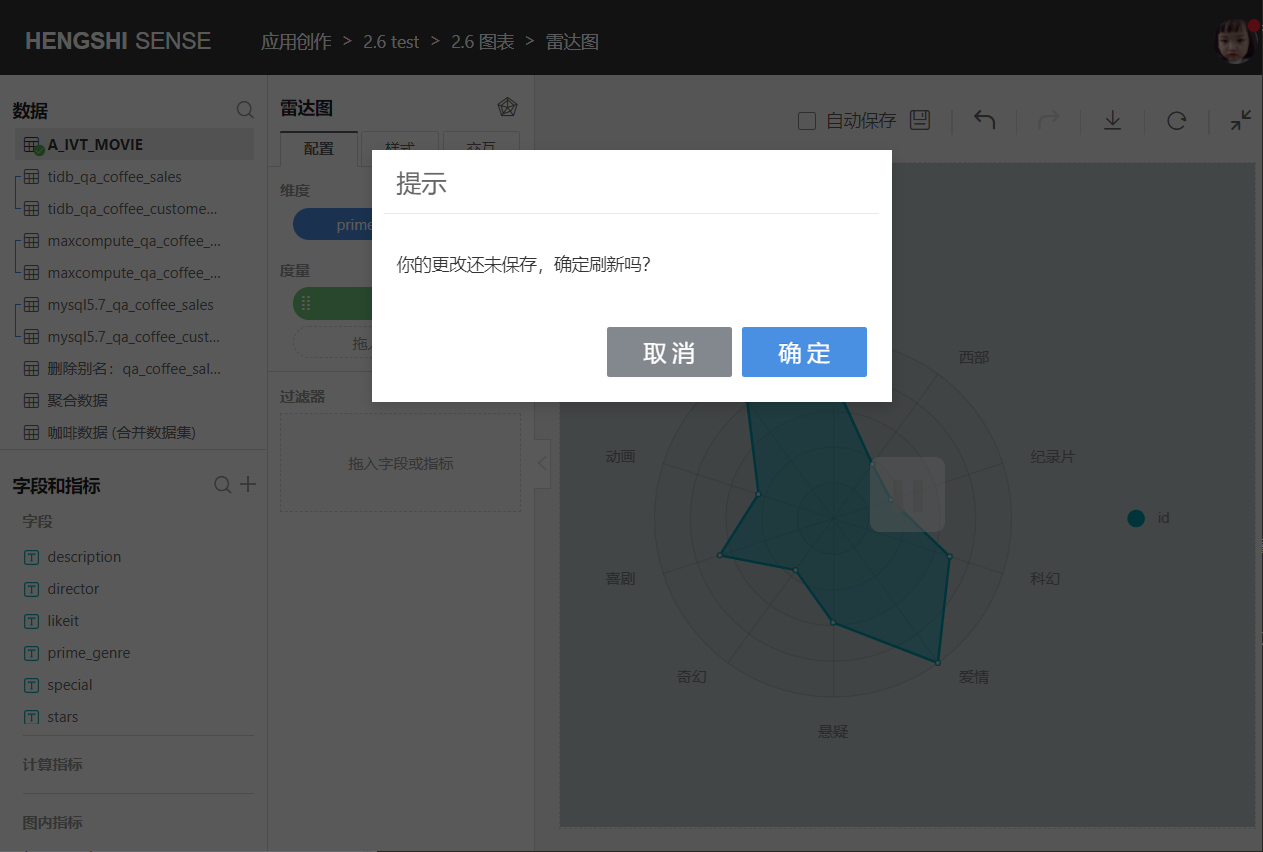
Undo
You can undo previous operations.
Redo
Redo the undone operation.
Export
Charts can be exported in three formats: PNG, PDF, and Excel aggregated result data. 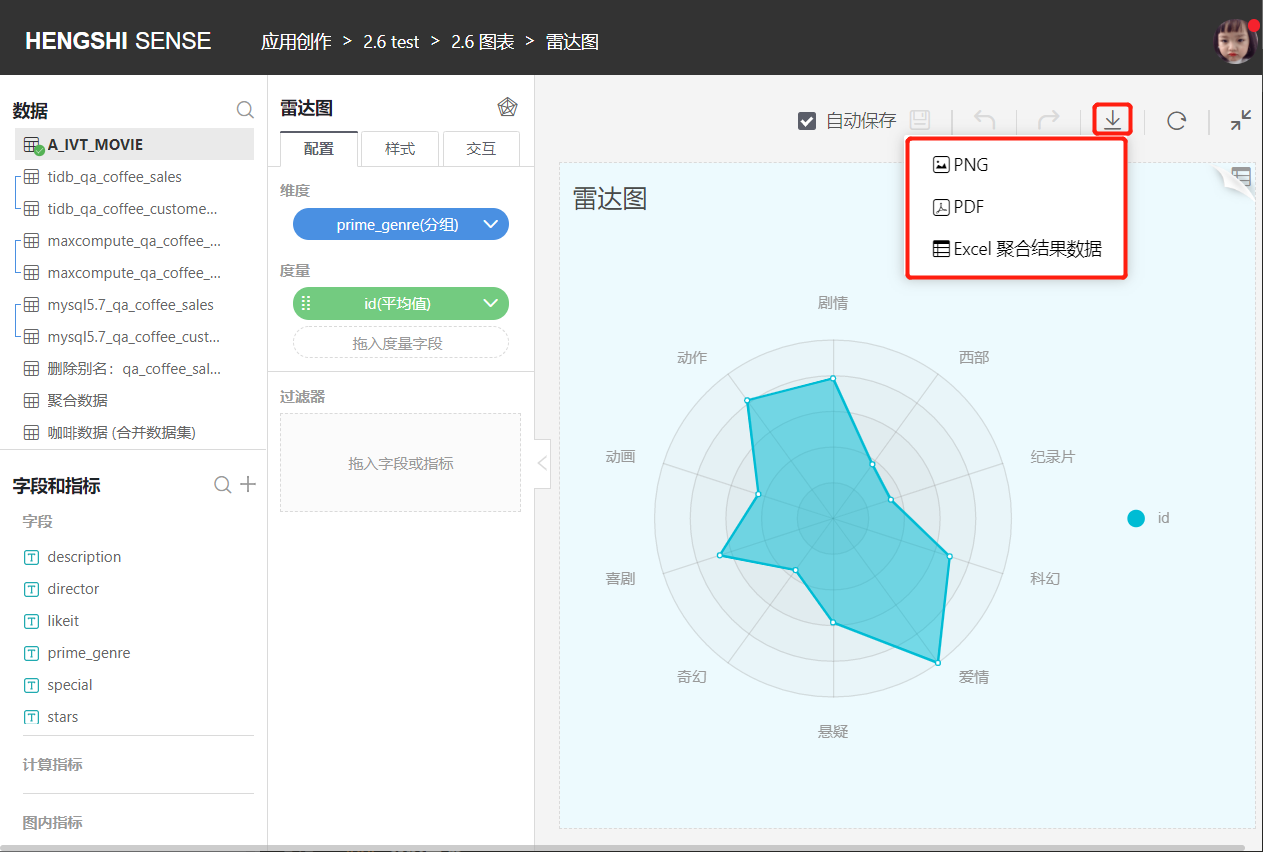
Refresh
Refresh the chart data directly without using cached chart data.
SQL Debugging
When designing charts, different data is required, and the calculations for these data can range from simple to complex. Sometimes, the backend response can be slow when calculating this data. If you wish to understand the SQL being executed in the backend and troubleshoot and optimize it, you can use this feature.
SQL Debugging provides the following two functions:
- View SQL Code
- View the explain results of the SQL code's execution plan
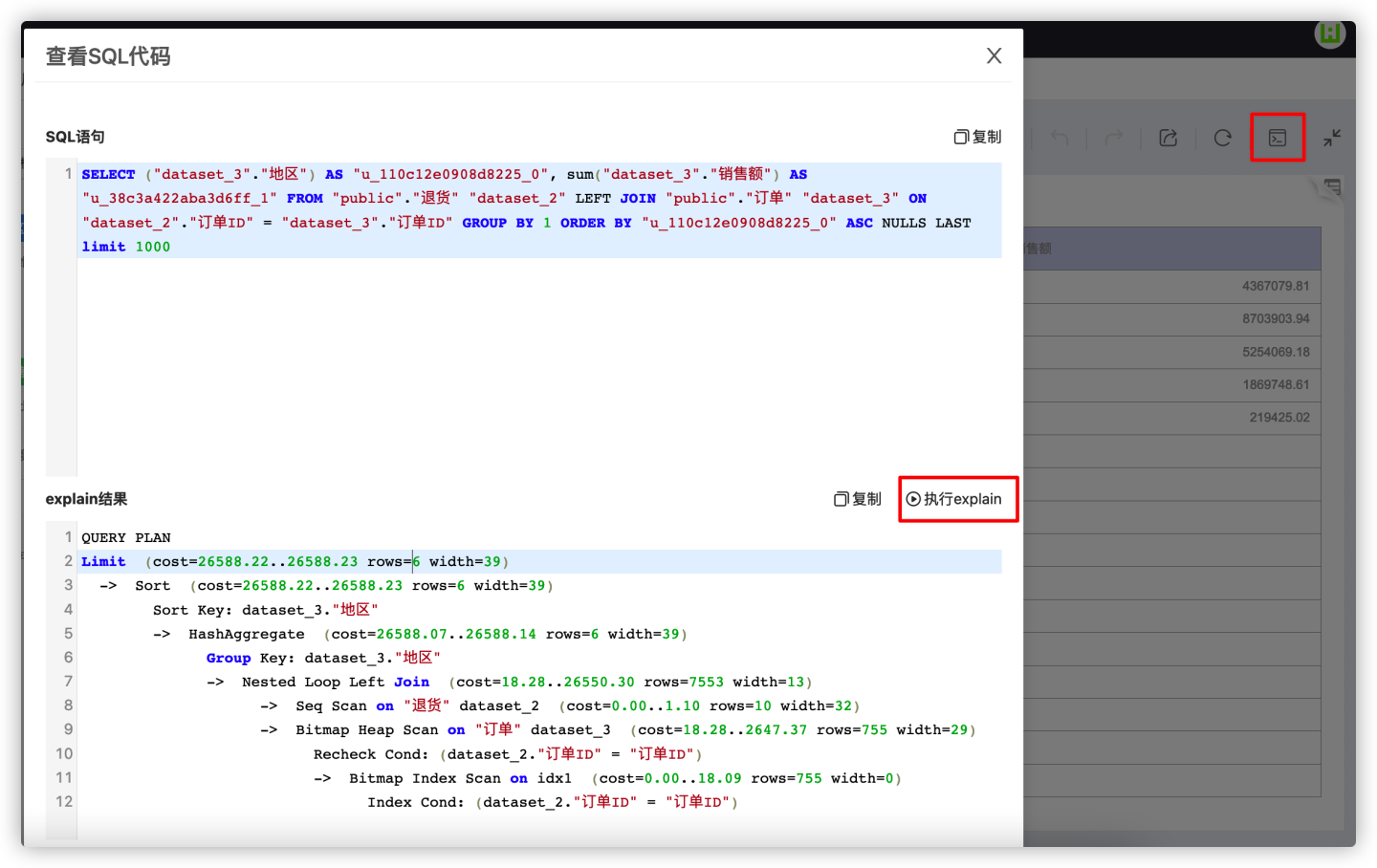
If you find that the performance of a certain chart is not ideal, you can first check whether the executed SQL code is reasonable and whether the calculation expressions for dimensions and measures can be adjusted. Then, you can use the explain function to view the execution plan. If you find that certain operations in the execution plan are taking a long time, you can perform corresponding optimization work for different situations. For example, if most of the time in the execution plan is spent repeatedly performing table scan operations, you might consider creating some indexes on the relevant columns of the related tables to speed up the execution of the chart.
Return
Return to the Dashboard page.
View Data
View the raw data of the current chart. 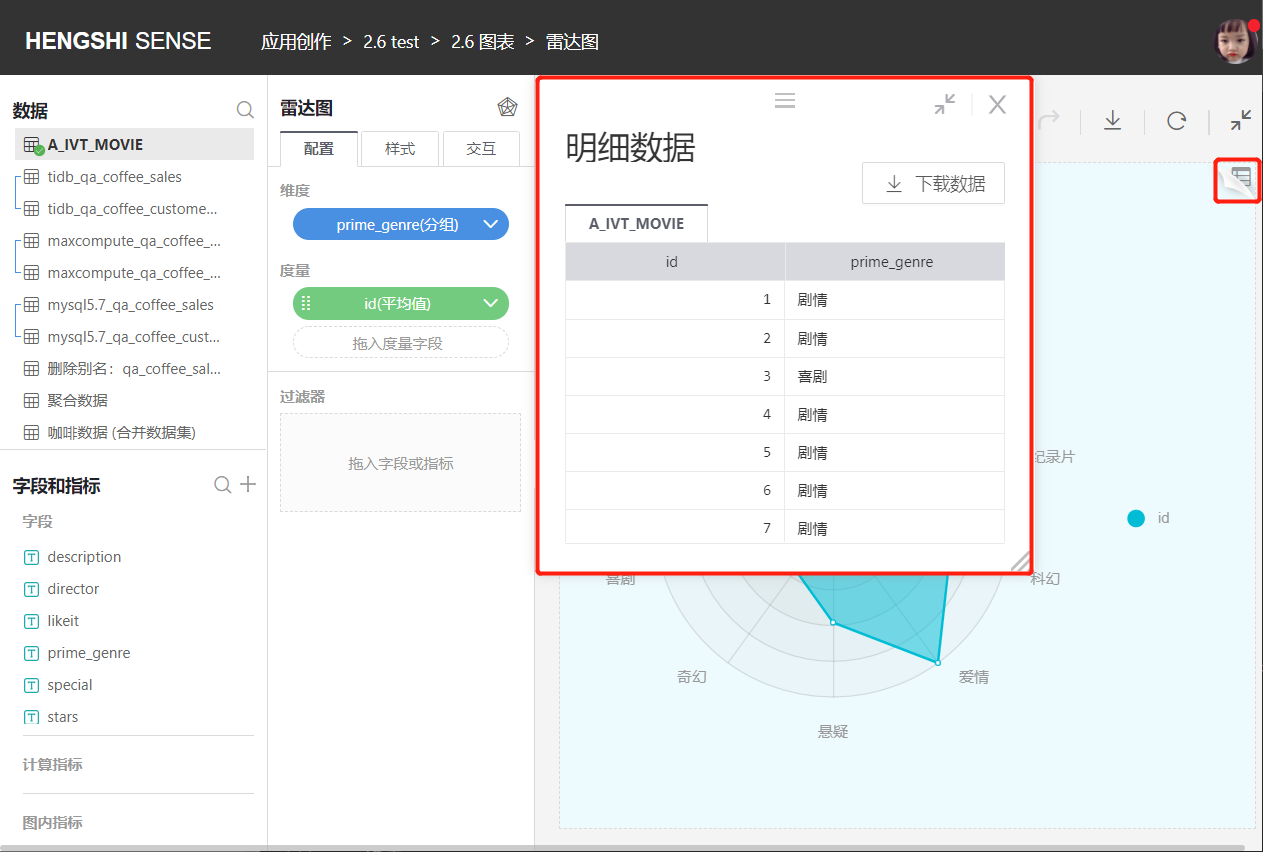
Middle Toolbar
Switch Charts
Users can switch between different chart types based on their needs. Colored icons can be switched directly without the need for reconfiguration, while gray icons will not retain the dimensions and measures of the chart after switching, requiring users to reconfigure the measures and dimensions themselves. 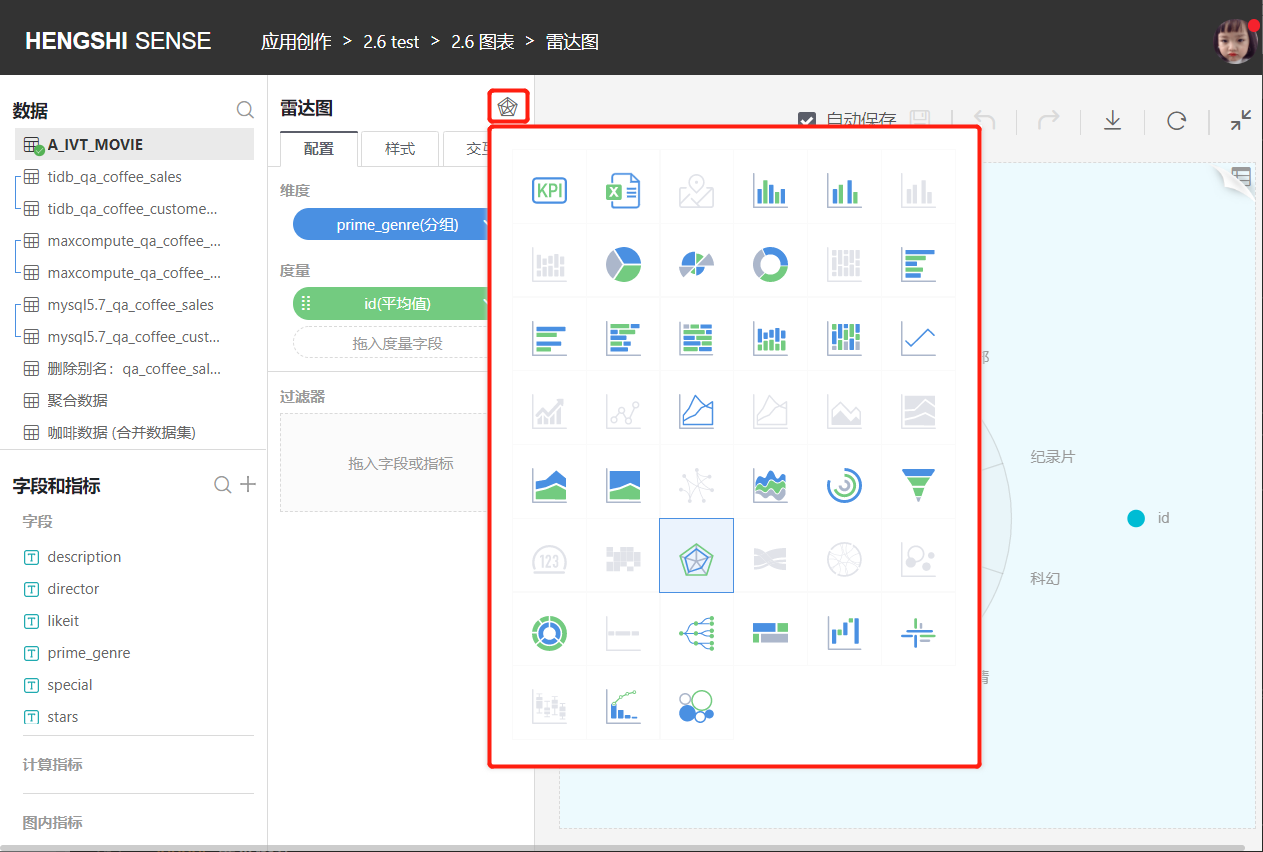
Configuration
Select Configuration from the middle navigation bar to optimize the complete chart according to your needs.
- Dimensions
- Measures
- Filters
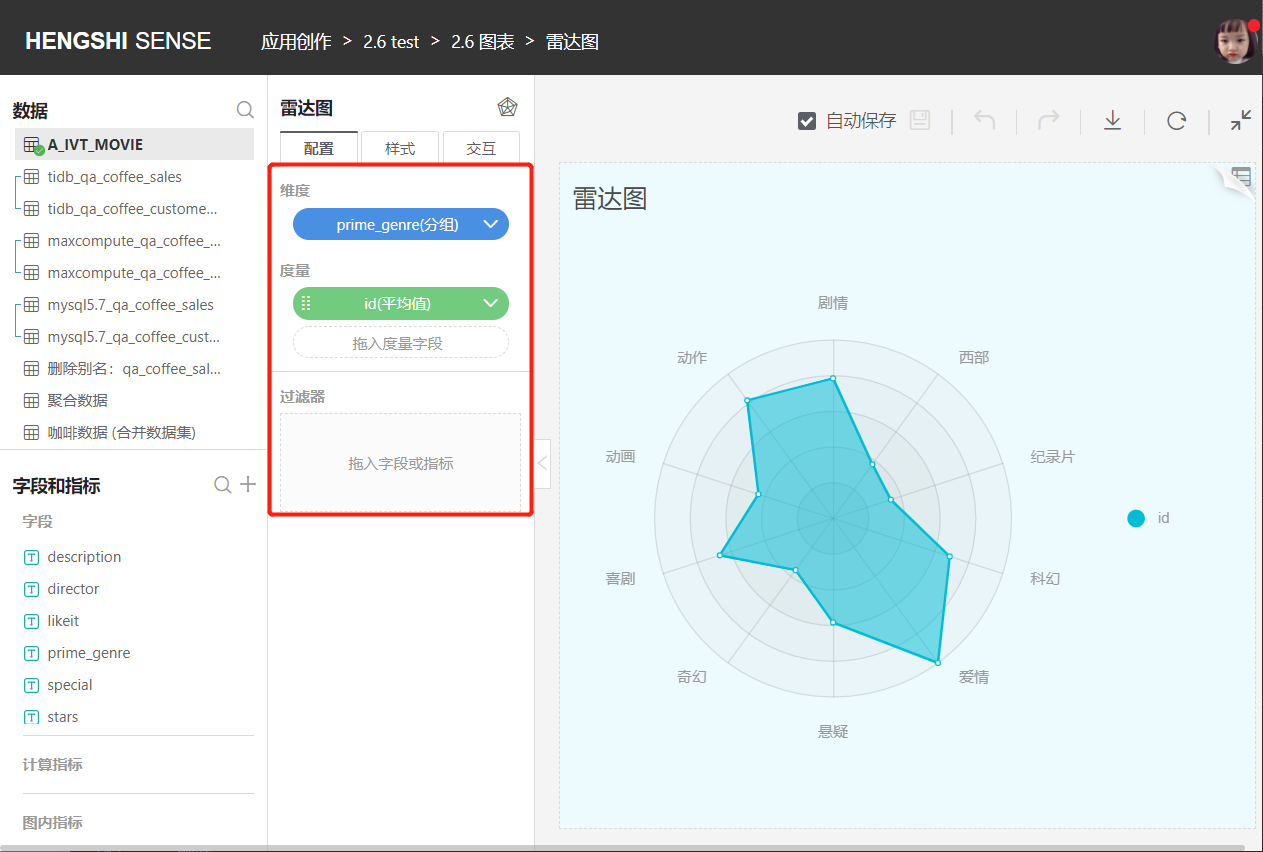
Dimension Tools
Dimension tools include:
- Rename: Modify the dimension name to make the content in the chart more relevant to the business scenario.
- Display Format
- Sort
- Calculation: Dimension aggregation methods.
- Merge Items: Merge items that account for a very small proportion.
- Fill Time Points: When selecting a time dimension, the option to fill time points will appear.
- Delete: Remove the current dimension.
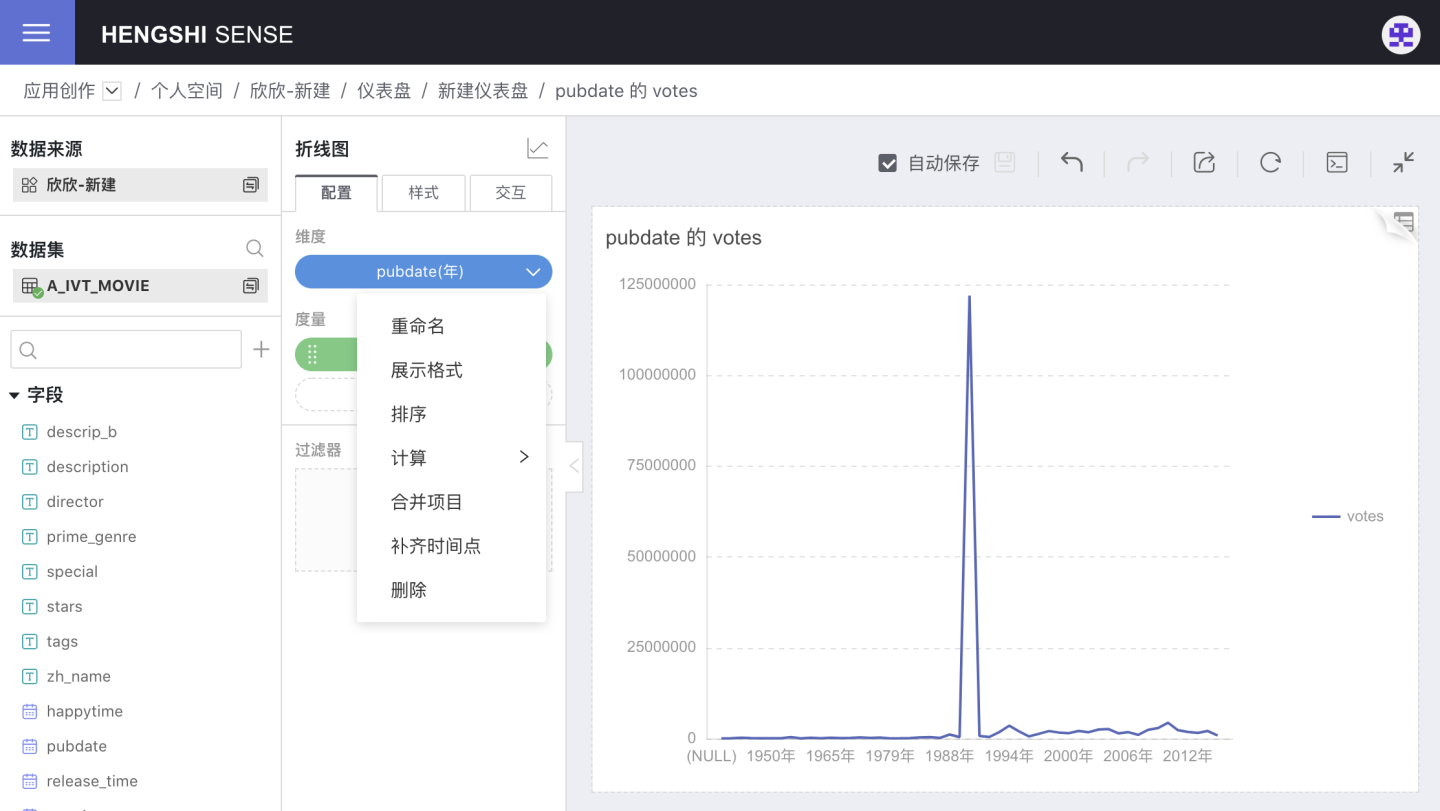
Display Format
The display format for numeric types is as follows, and the number display format can be customized: 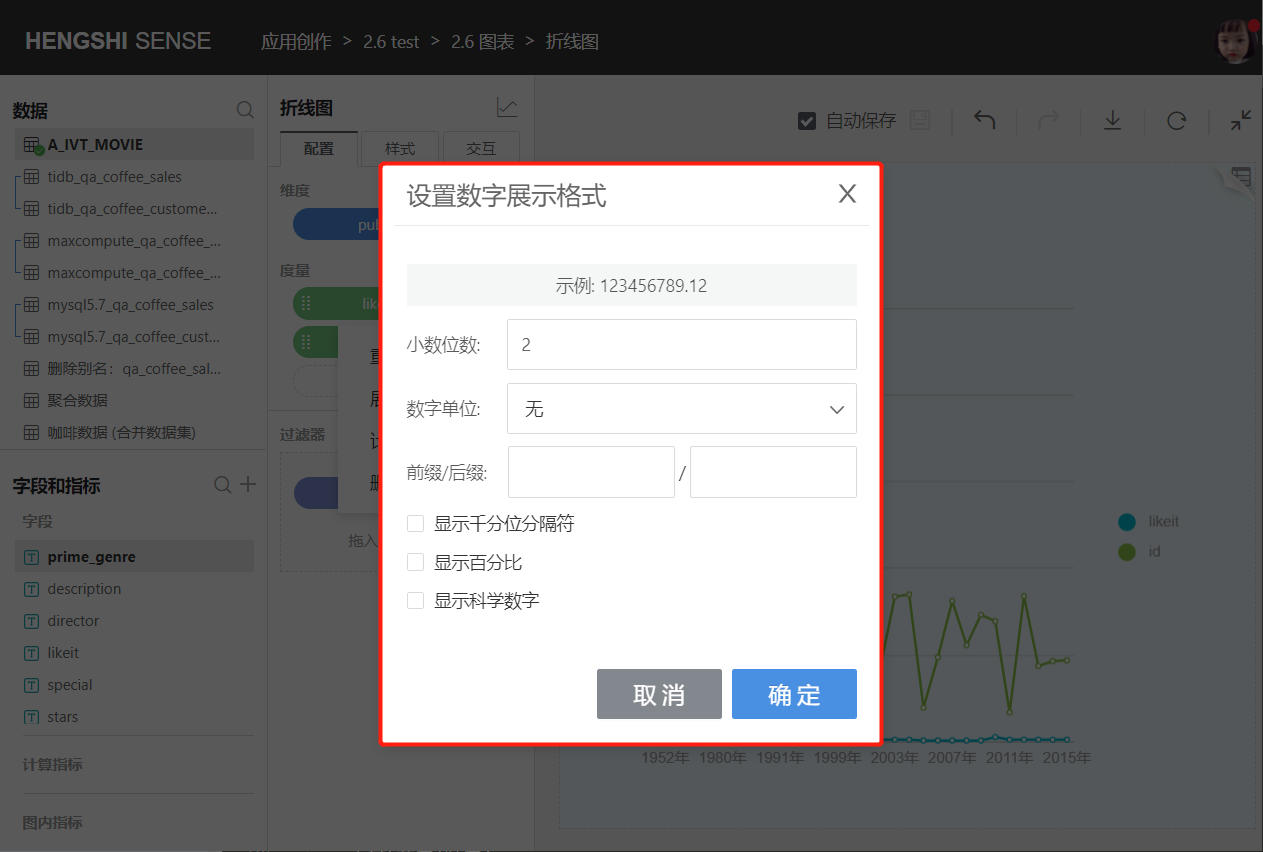
- Decimal Places: By default, it displays 2 decimal places, and the number of decimal places can be customized.
- Number Units: By default, it displays no units, and the number units can be customized: Auto, Hundred Million, Ten Million, Million, Ten Thousand, Thousand, Hundred, M, K.
- Prefix/Suffix: By default, it displays no prefix/suffix, and the prefix/suffix can be customized.
- Display Thousand Separator: By default, it is not checked, and users can customize it according to actual needs.
- Display Percentage: By default, it is not checked, and users can customize it according to actual needs.
- Display Scientific Notation: By default, it is not checked, and users can customize it according to actual needs.
The display format for date types is as follows, and the date display format can be customized: 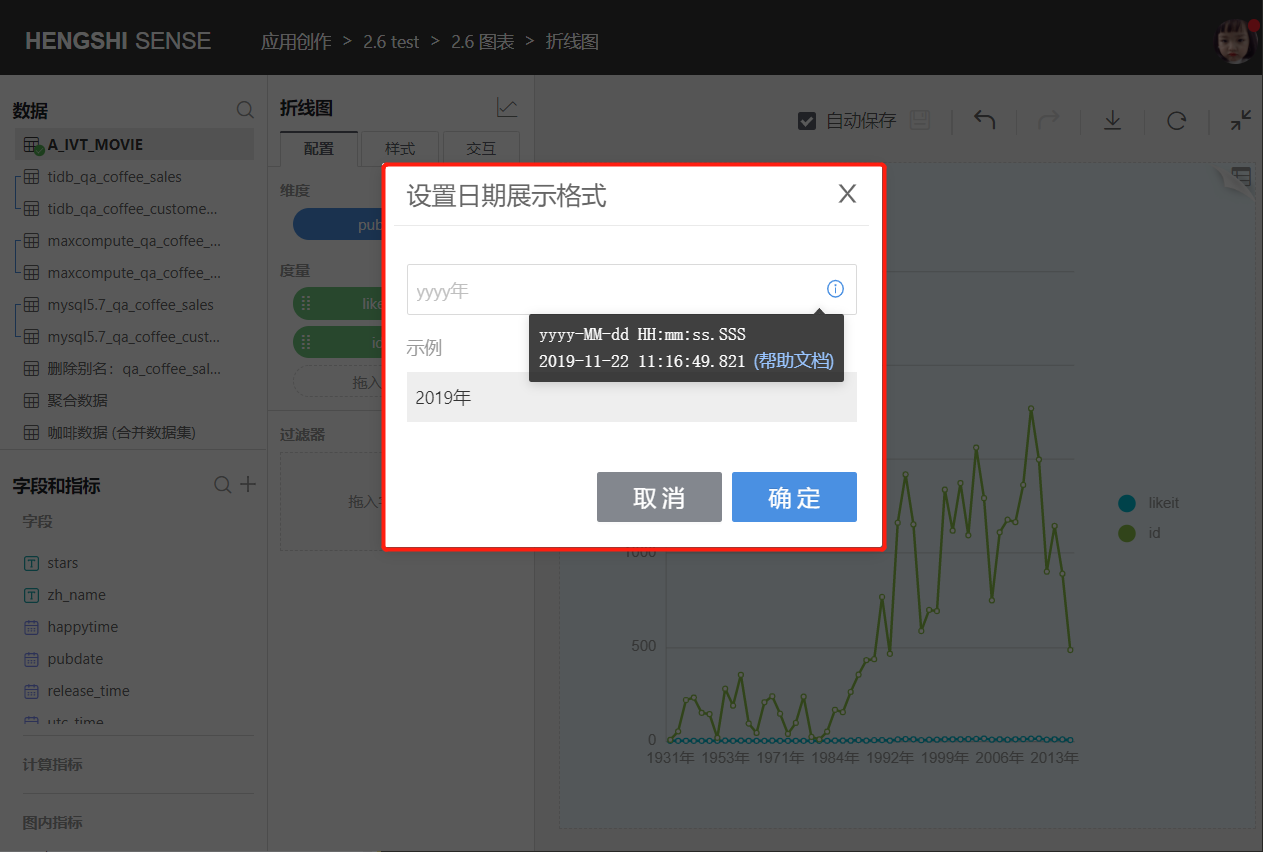
Sorting
Dimension sorting criteria include: data source sorting, alphabetical, field, and manual sorting.
Click the dropdown box on the right side of the dimension field to pop up the menu, then click sort. 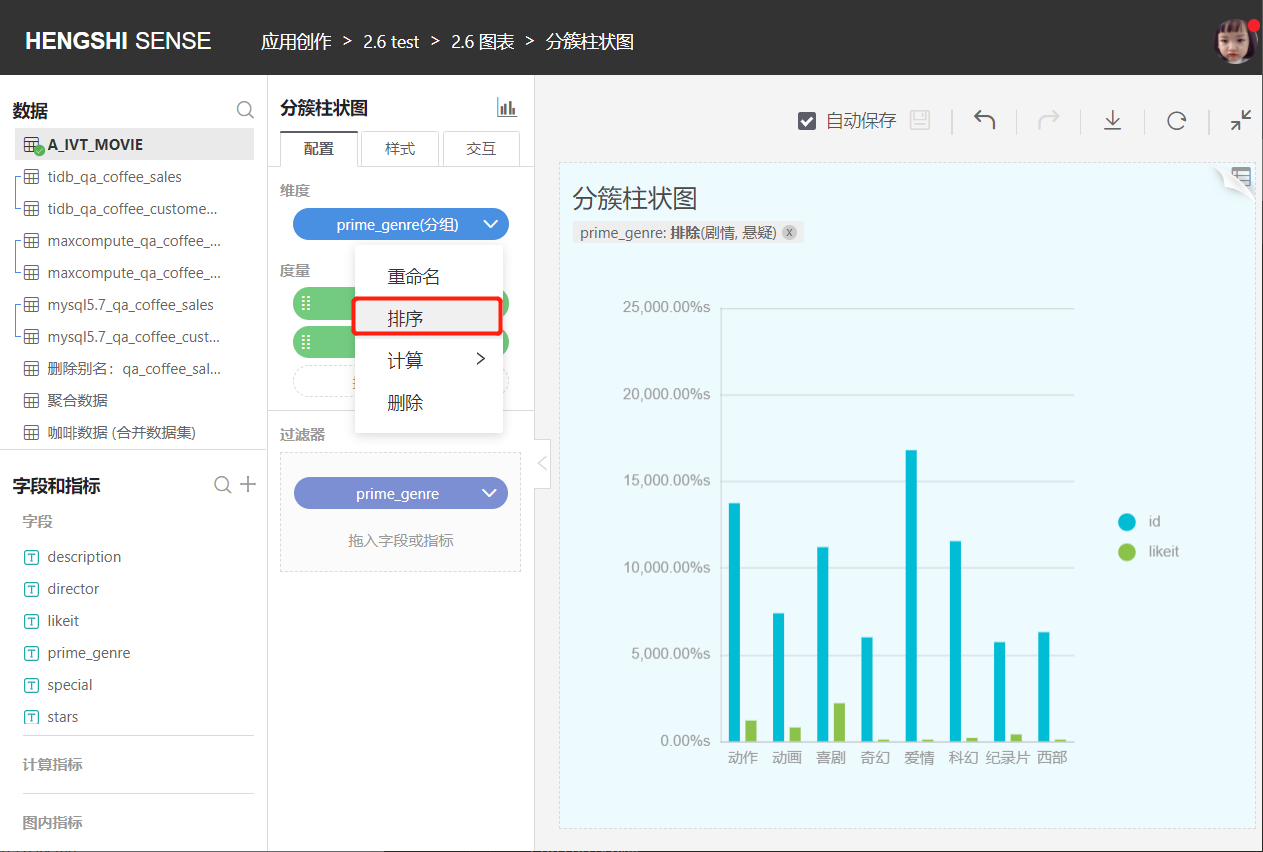
Data Source Sorting: Sort dimensions based on the storage location of the data in the database.
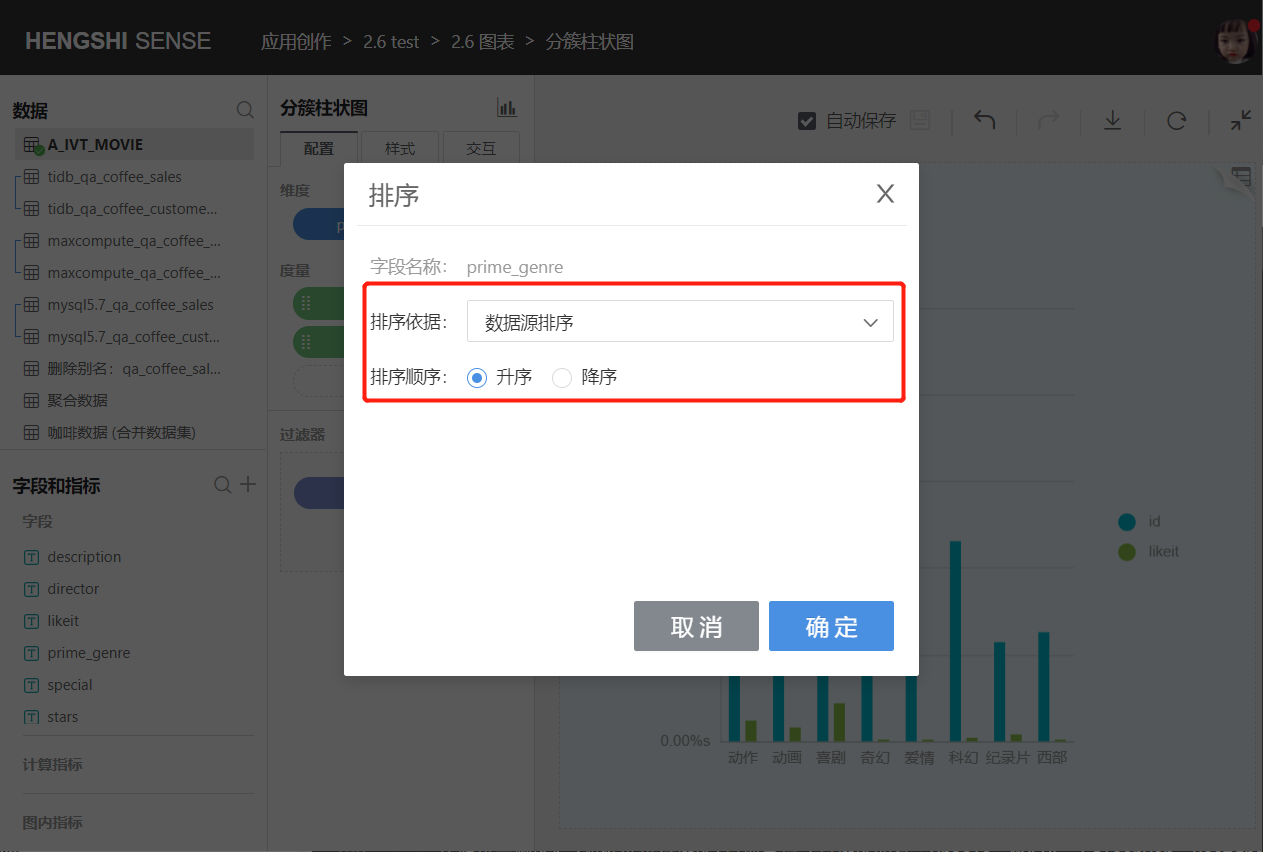
Alphabetical: Sort dimensions in alphabetical order A-Z; currently supported databases for alphabetical sorting include: Oracle, MySQL, Sqlserver, PostgreSQL, GreenPlum, and Engine.
Date and numeric type dimension fields do not support alphabetical sorting. 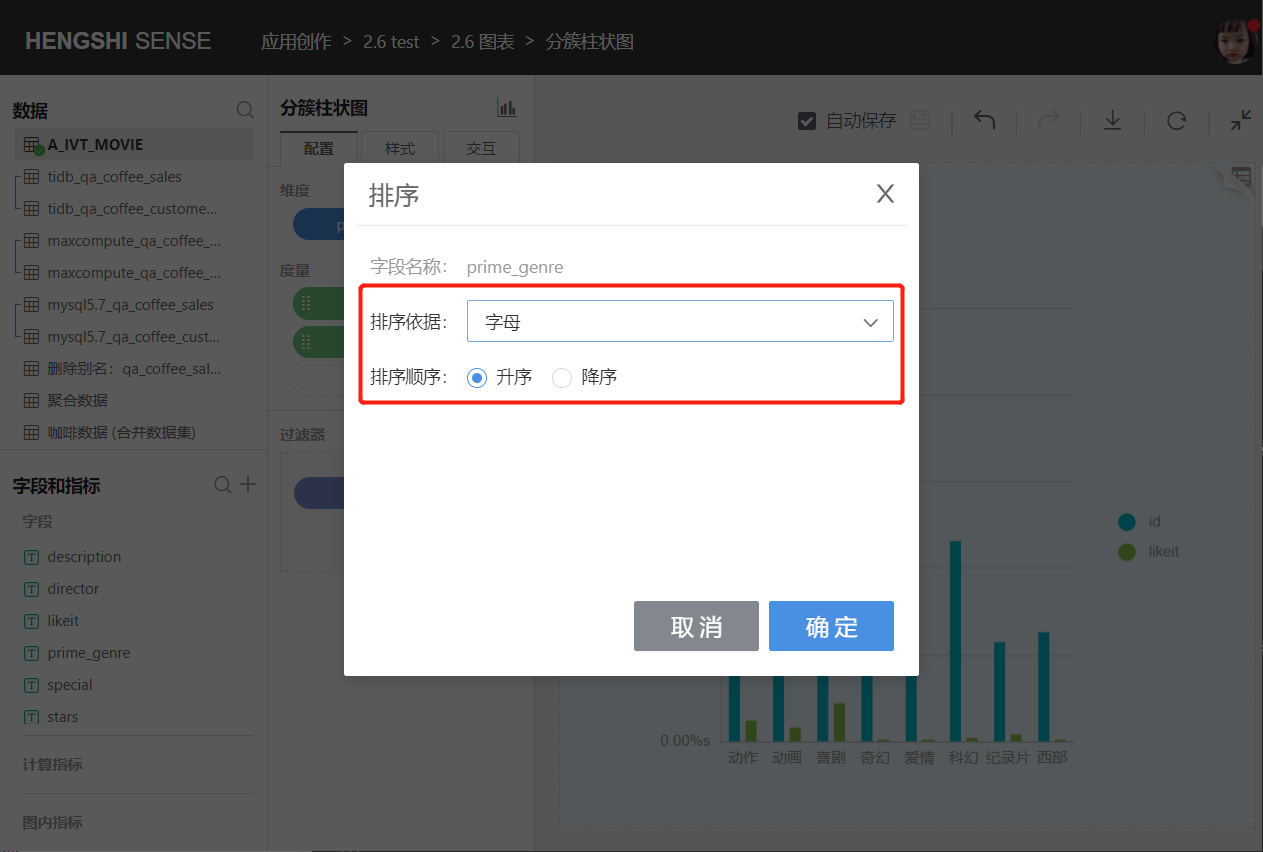
Field: You can select fields from the same dataset or related datasets, specify aggregation methods, and sort dimensions based on the aggregated results.
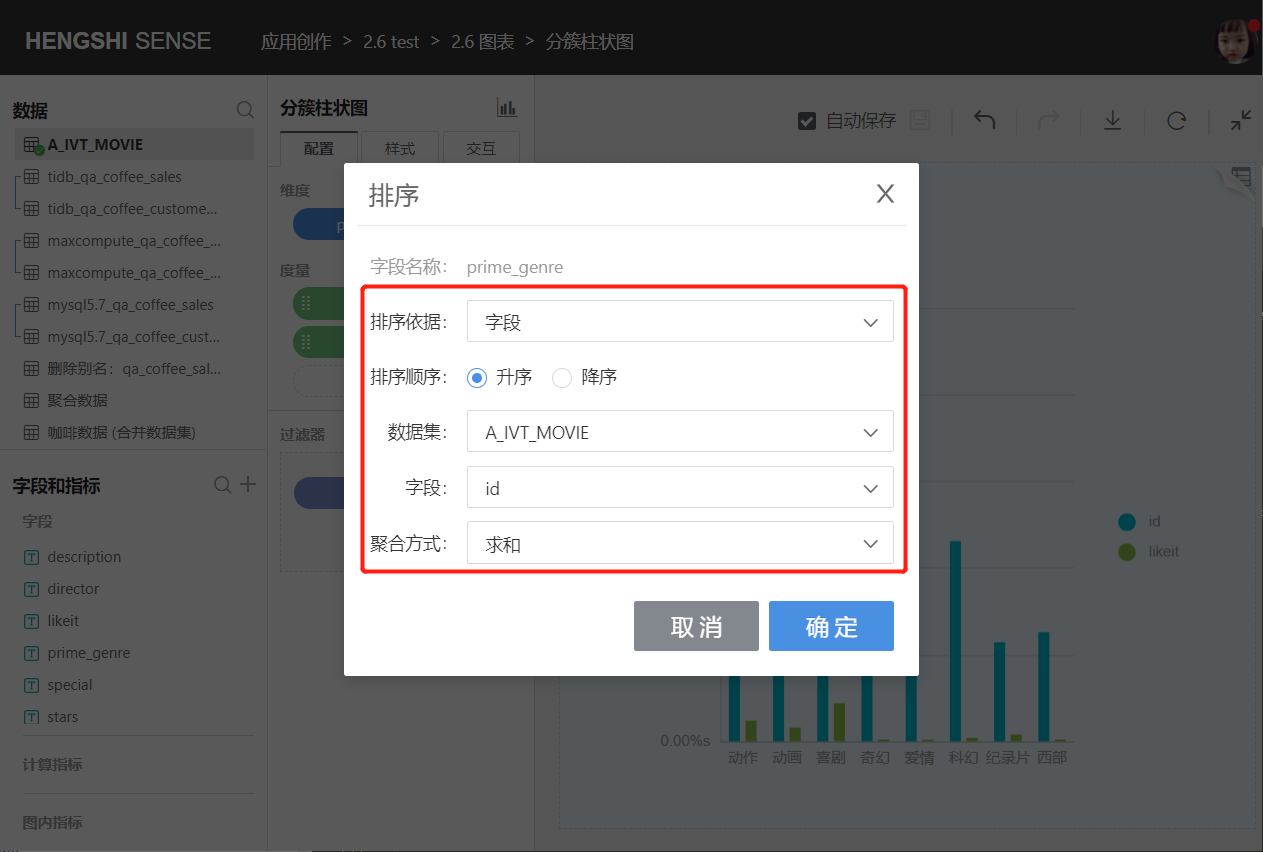
Manual Sorting: You can manually adjust the order of dimension groups.
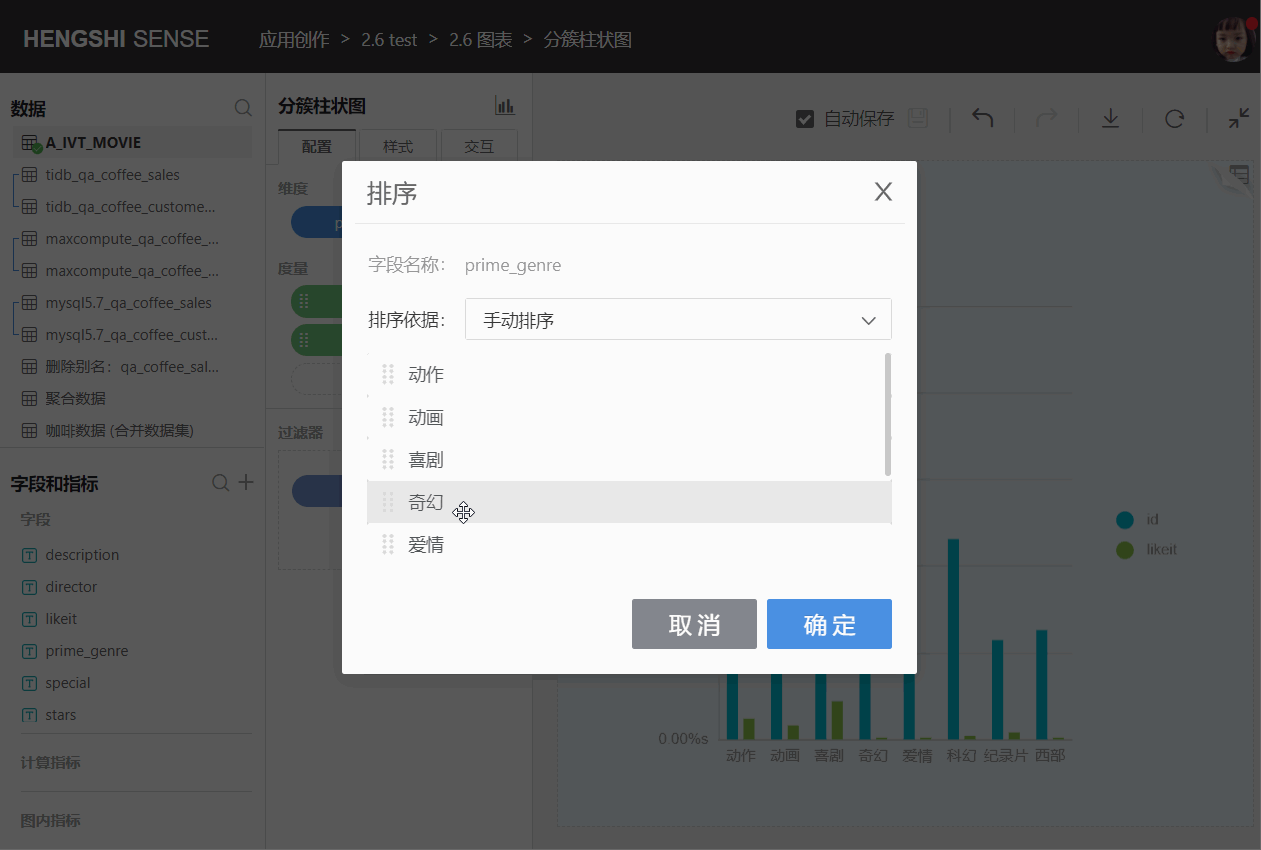
Comparison dimension sorting includes: default, ascending, descending, and custom.
Click the dropdown box on the right side of the comparison dimension to pop up the menu, then click sort. 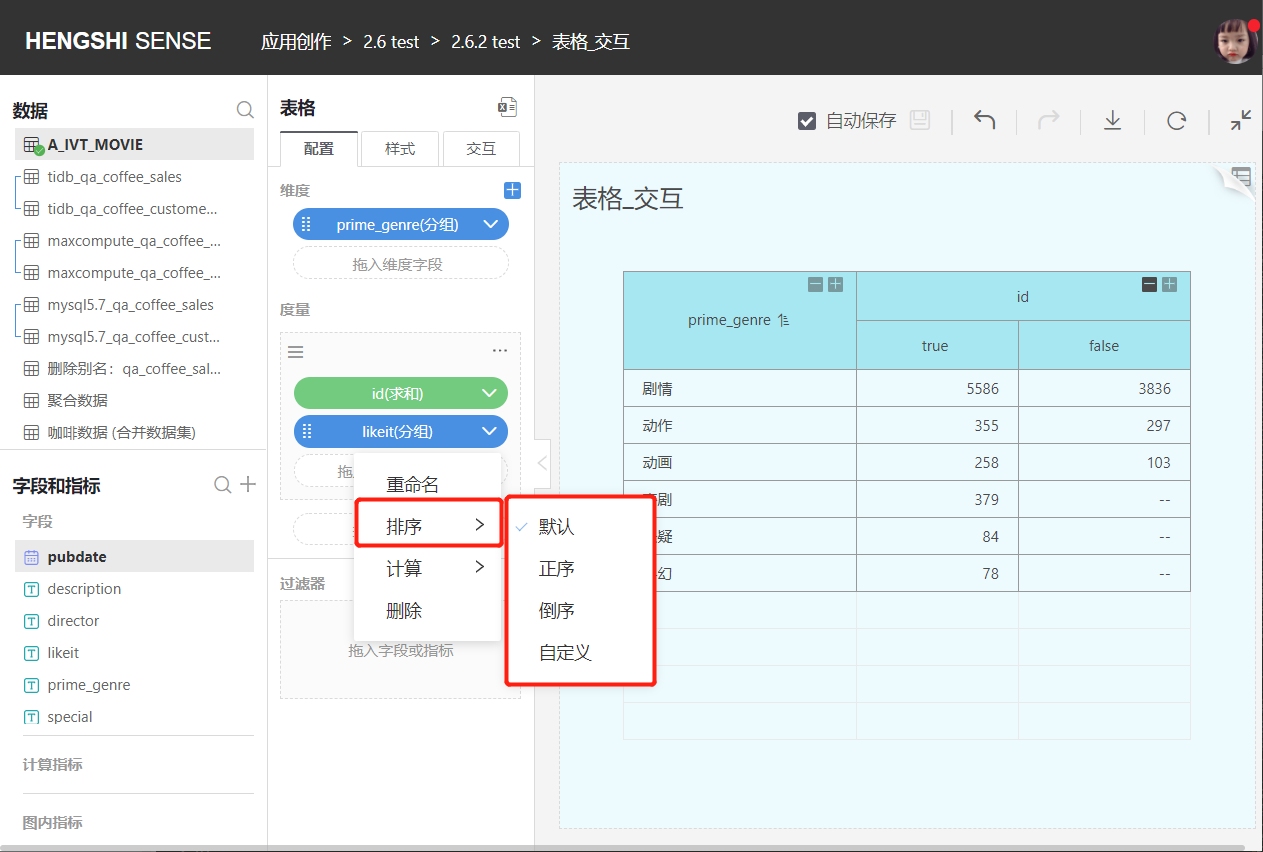
Default: By default, there is no order. If the comparison dimension selects the same field as the dimension, it will be sorted according to the order of the dimension field.
Ascending/Descending: When selecting ascending/descending, text type fields are sorted in alphabetical order A-Z, numeric type fields are sorted by numerical value, and date type fields are sorted by date.
Custom Sorting: You can manually adjust the order of comparison dimension groups.
Tip
Only tables support comparison dimensions.
Calculation
The aggregation method for non-time dimensions is grouping, while the aggregation methods for time dimensions include:
- Millisecond
- Second
- Minute
- Hour
- Day
- Day (Cross Week)
- Day (Cross Month)
- Week
- Month
- Month (Cross Year)
- Quarter
- Quarter (Cross Year)
- Year

Merge Items
Charts with dimensions (except for maps) support merging items into "Others". When the grouped data in the display process only focuses on items with a higher proportion, items with a smaller proportion can be merged into "Others". The chart displayed after merging is more concise and clear.
The merged groups also support operations such as drilling down, viewing details, and linkage filtering. 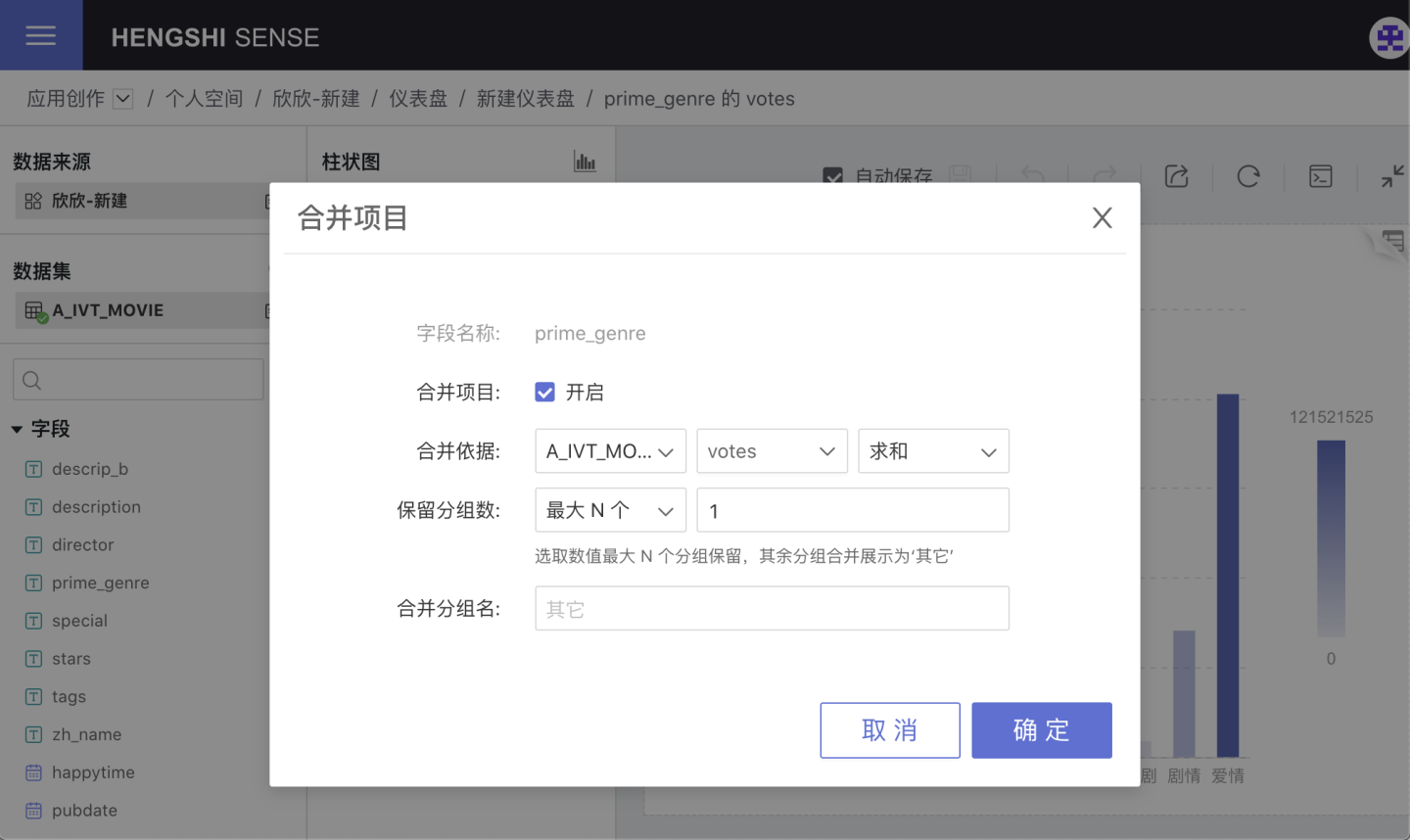
Completing Time Points
Currently, the charts that support completing time points are:
- Line Chart
- Grouped Line Chart
- Line and Bar Combination Chart
- Area Chart
- Grouped Area Chart
- Stacked Area Chart
- Stream Area Chart
- Grouped Stacked Area Chart
- 100% Stacked Area Chart
- 100% Grouped Stacked Area Chart
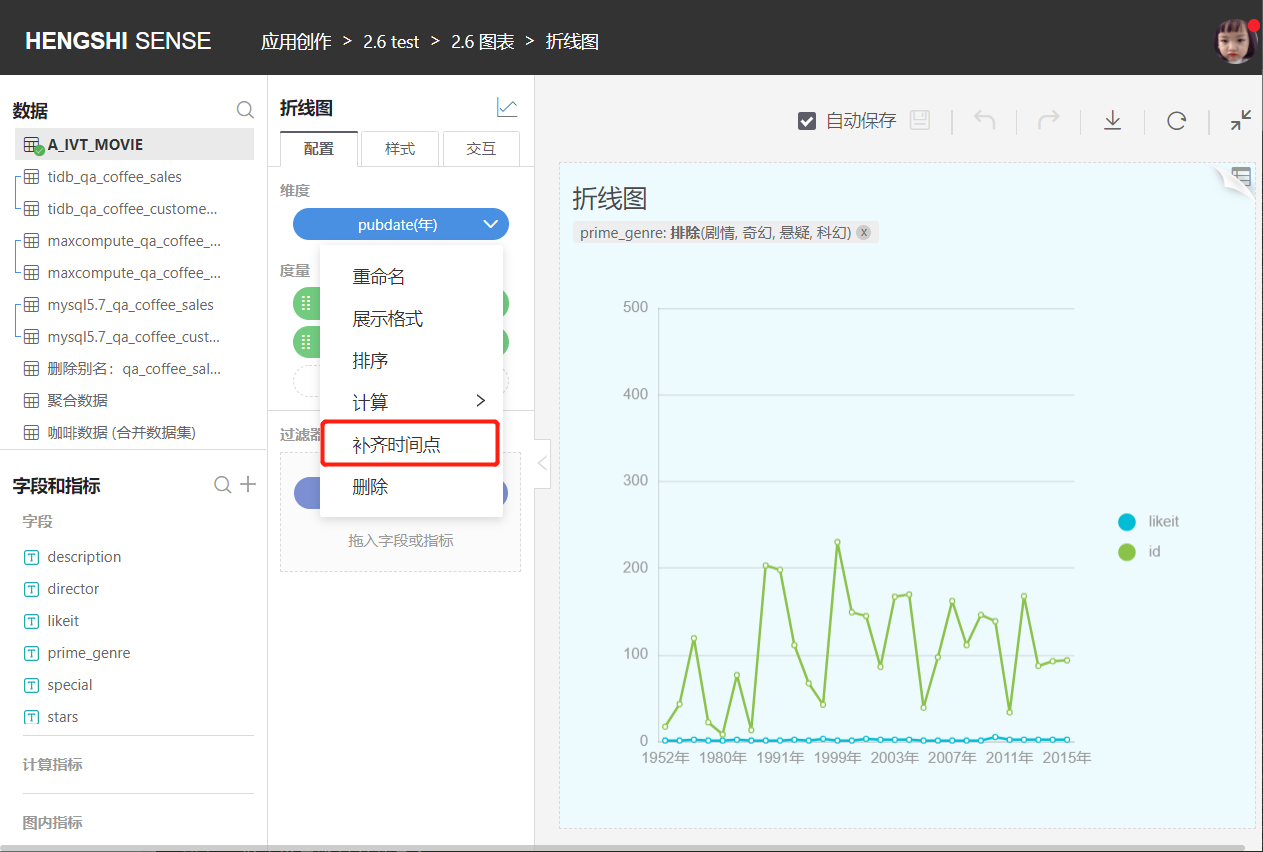
The charts with completed time points are shown as follows: 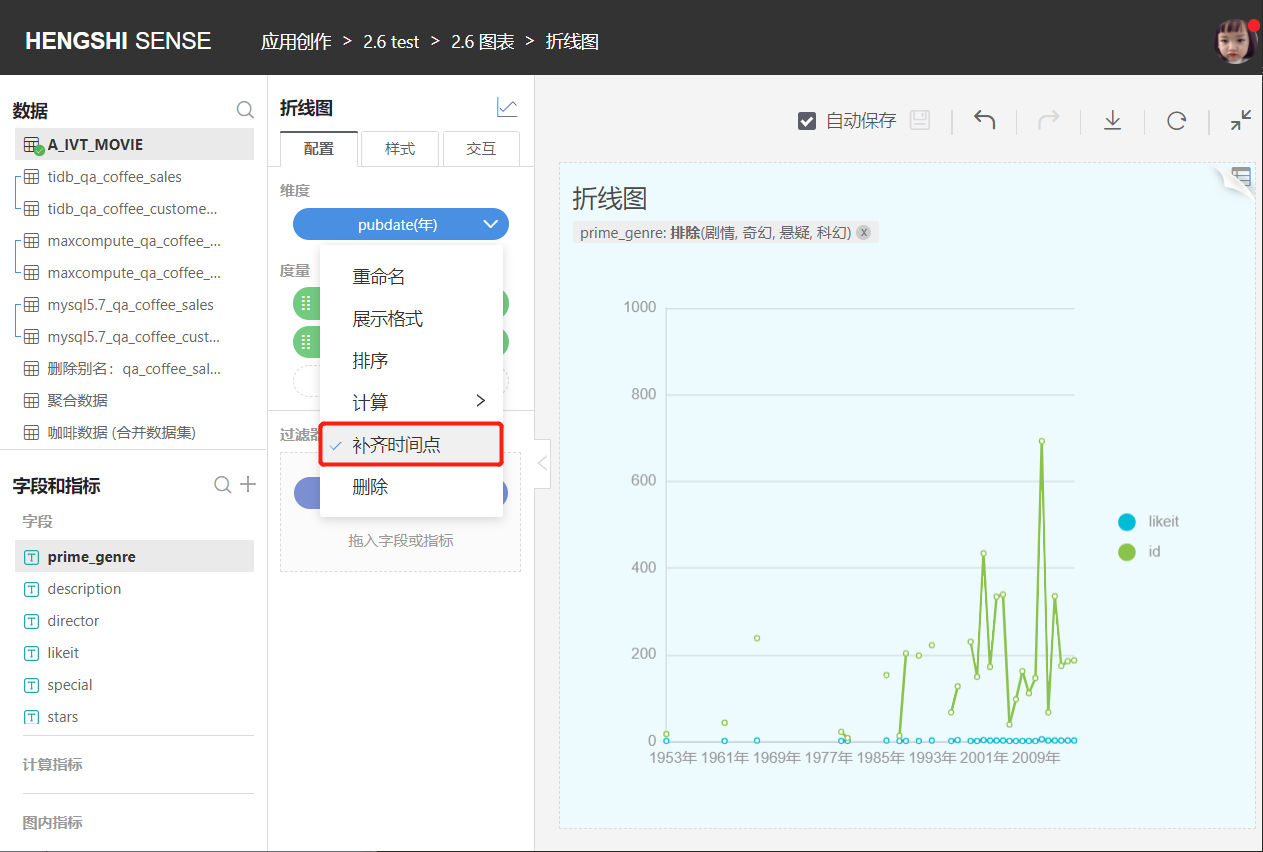
Measurement Tools
Measurement tools include:
- Rename: Modify the measurement name to make the content in the chart more relevant to the business scenario.
- Display Format
- Calculation: Measurement aggregation method.
- Delete: Remove the current measurement.
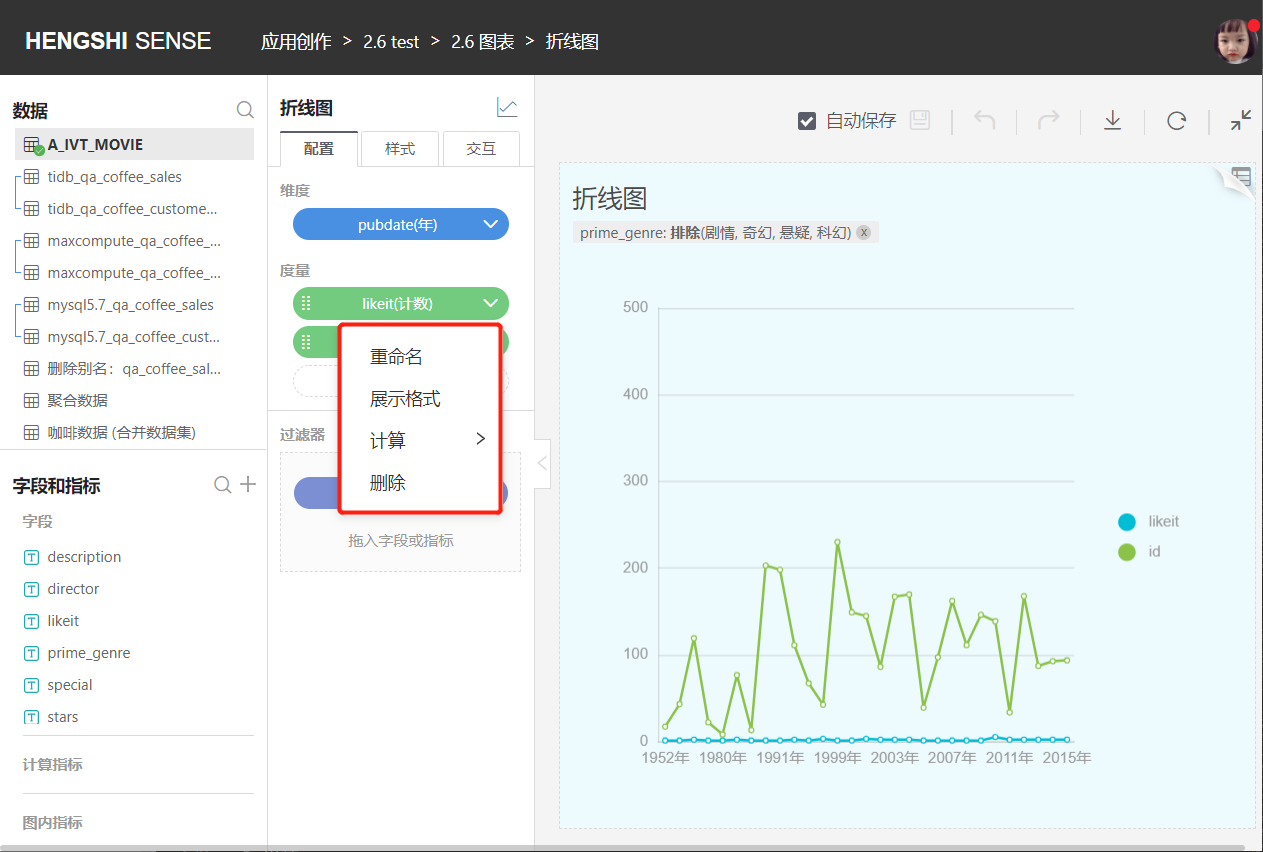
Display Format
Non-date type fields are displayed in numeric format; date type fields are displayed in date format.
Calculation
The aggregation methods for numerical metrics are:
- Sum
- Average
- Minimum
- Maximum
- Percentile
- Count
- Distinct Count
- Duplicate
- Retention
- Active
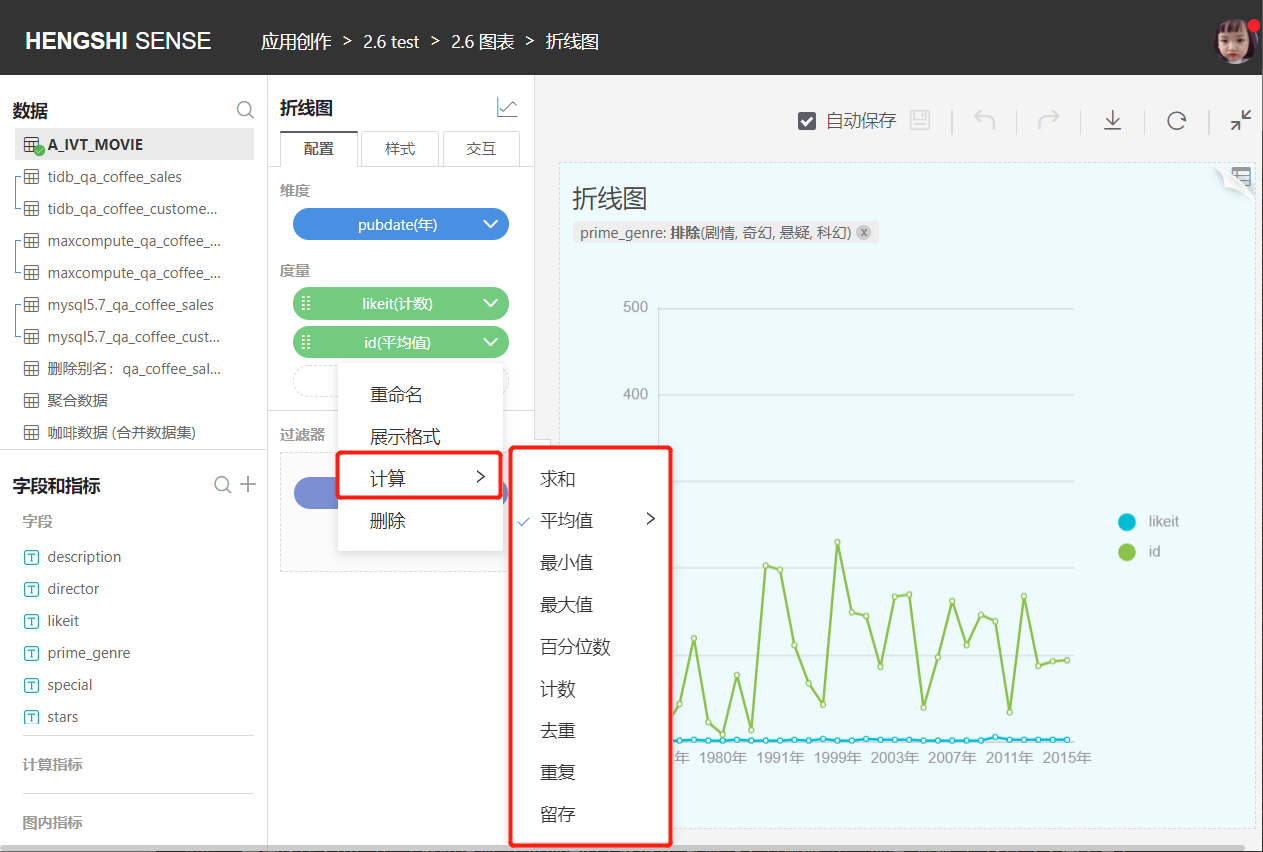
The aggregation methods for non-numerical metrics are:
- Count
- Distinct Count
- Duplicate
- Retention
- Active
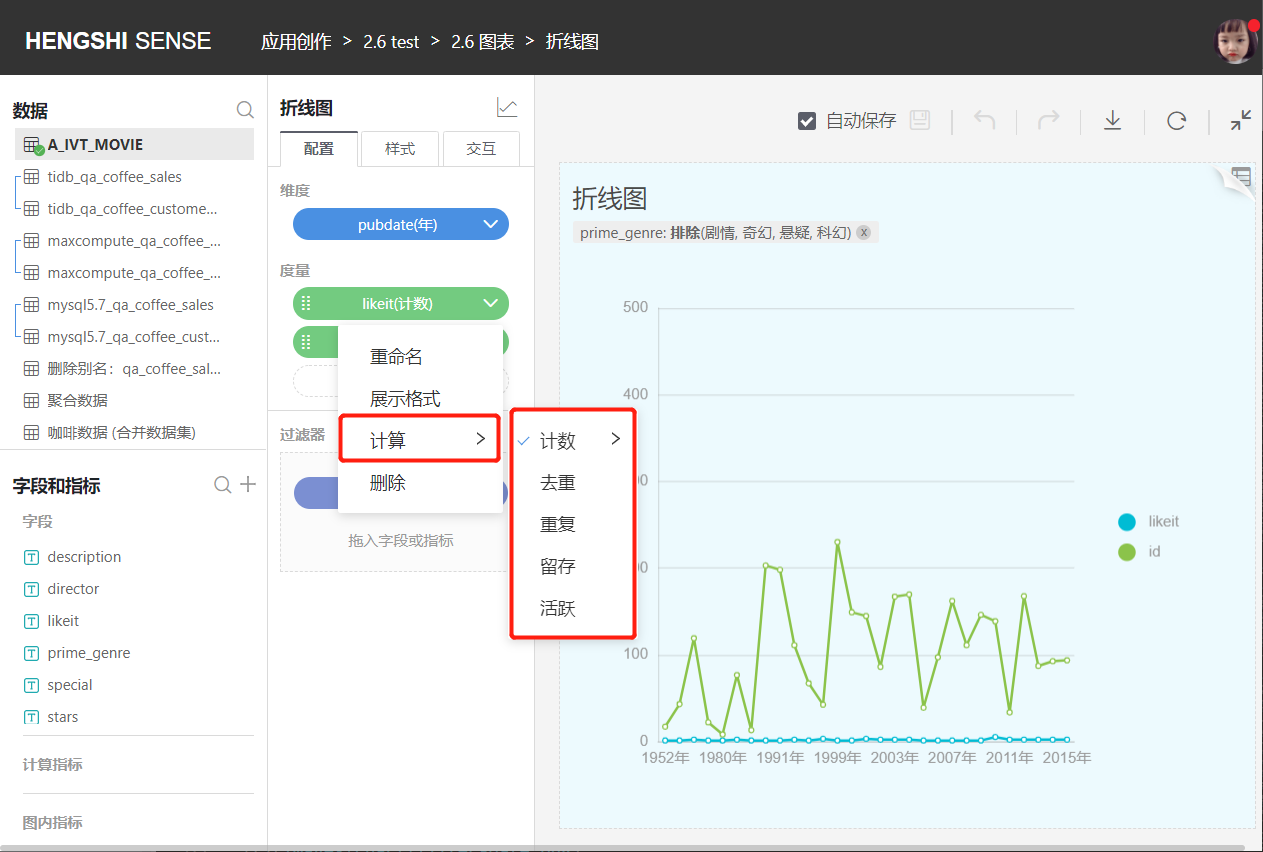
Filters
Drag fields from the Fields and Metrics on the left into the Configuration -> Filters area of the chart to add filter conditions to the chart.
Fields and Metrics include Raw Fields, In-Chart Metrics, and Calculated Metrics, and are categorized by field type. You can select and add filter conditions based on your needs.
- For text types, you can choose
Exclude/Includeto filter. - For numeric types, you can choose
Range/Comparisonto filter. - For date types, you can choose
Time Period/By Year/By Quarter/By Month/Rangeto filter. - For all types, you can also enter expressions in the
Expressionfield to filter. Functions Supported by Expressions
Tip
Filter expressions do not allow mixed operations of aggregate and non-aggregate expressions.
Drag fields into Configuration -> Filters: 
Text type field filtering: 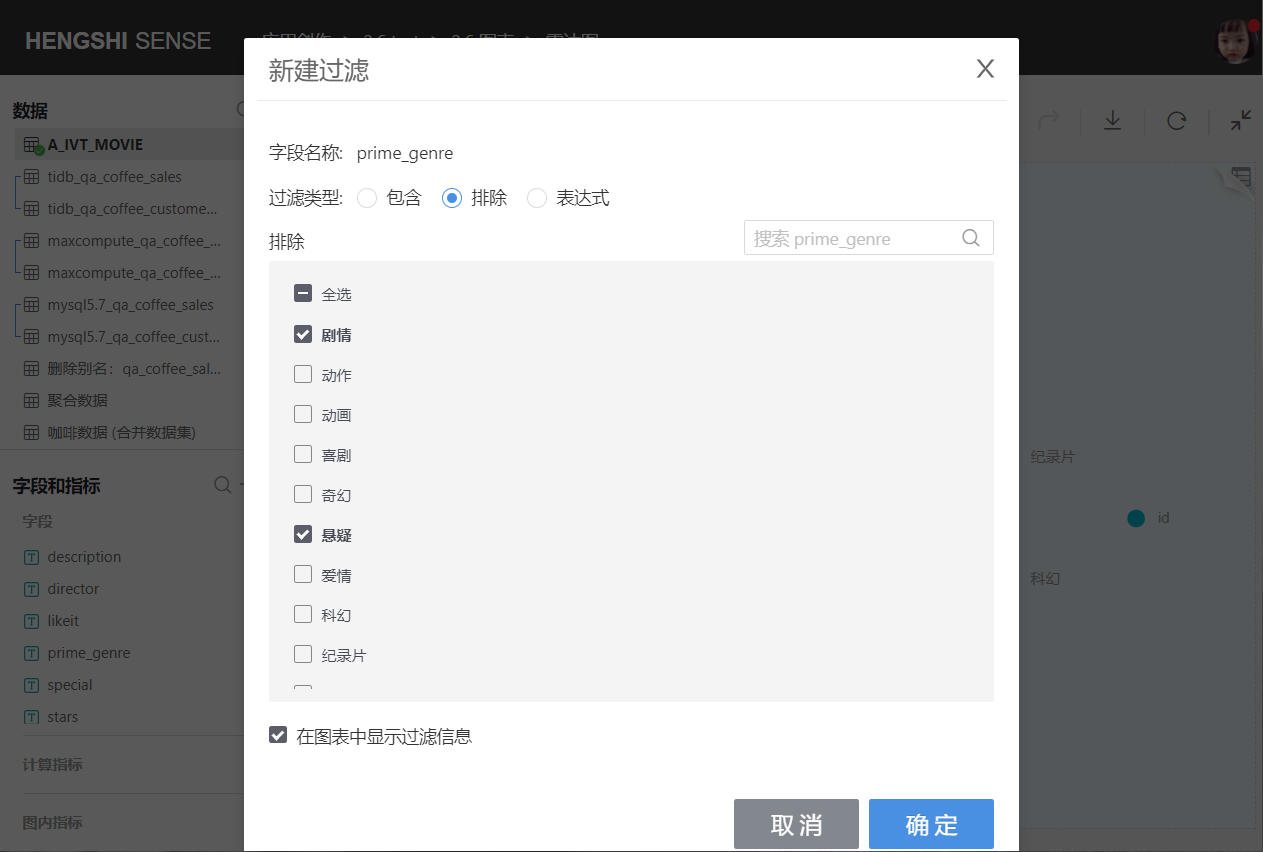
Numeric type field filtering: 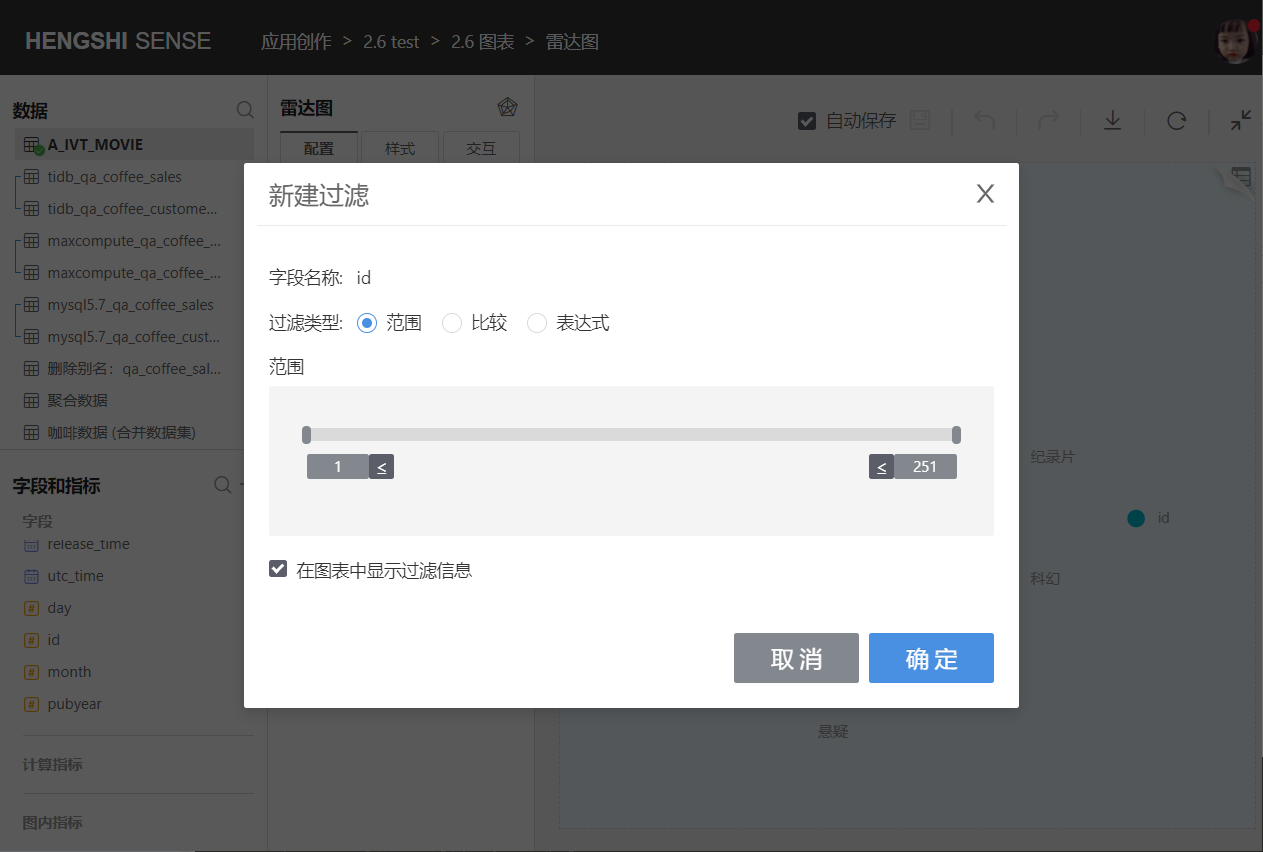
Date type field filtering: 
Expression filtering: 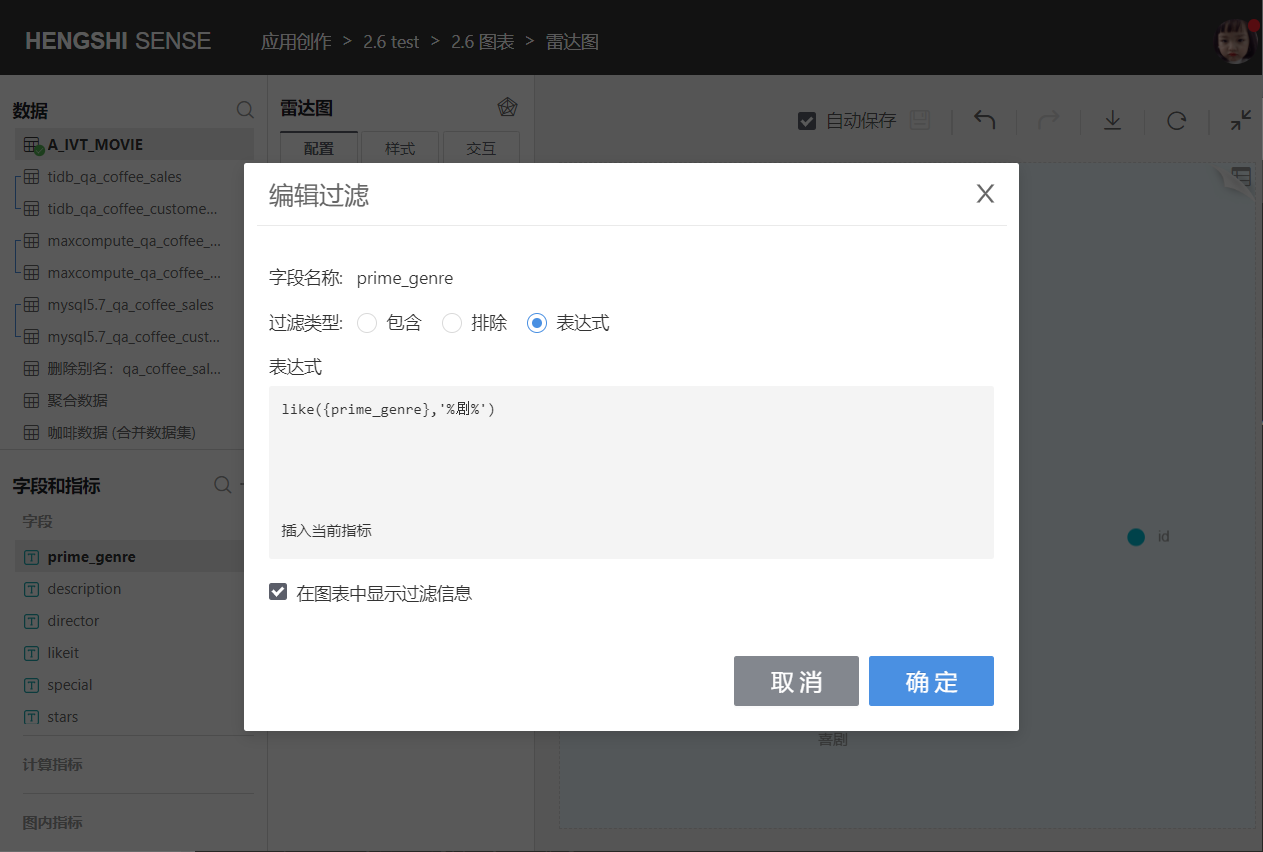
You can choose whether to display filter information during filtering: 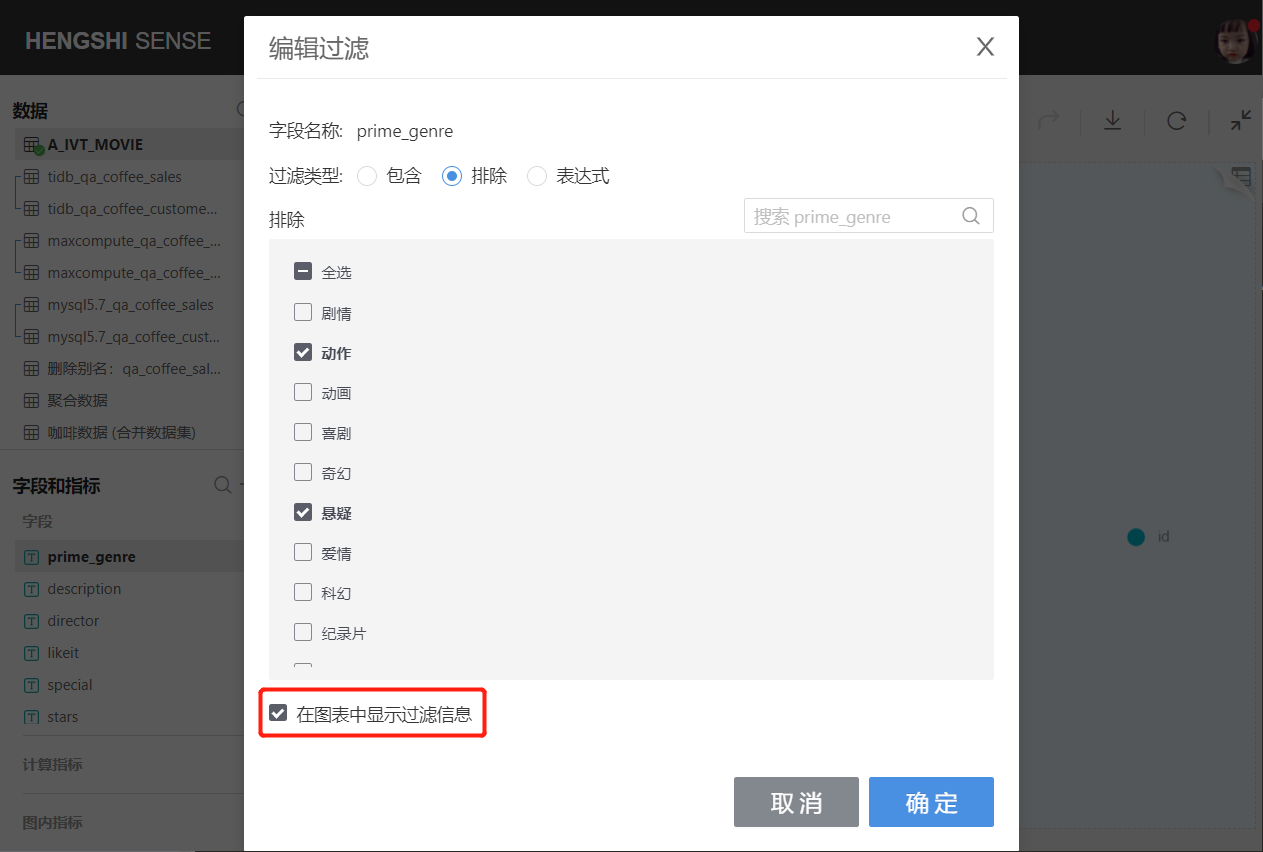
If you choose to display filter information, the filter conditions will be shown below the chart name: 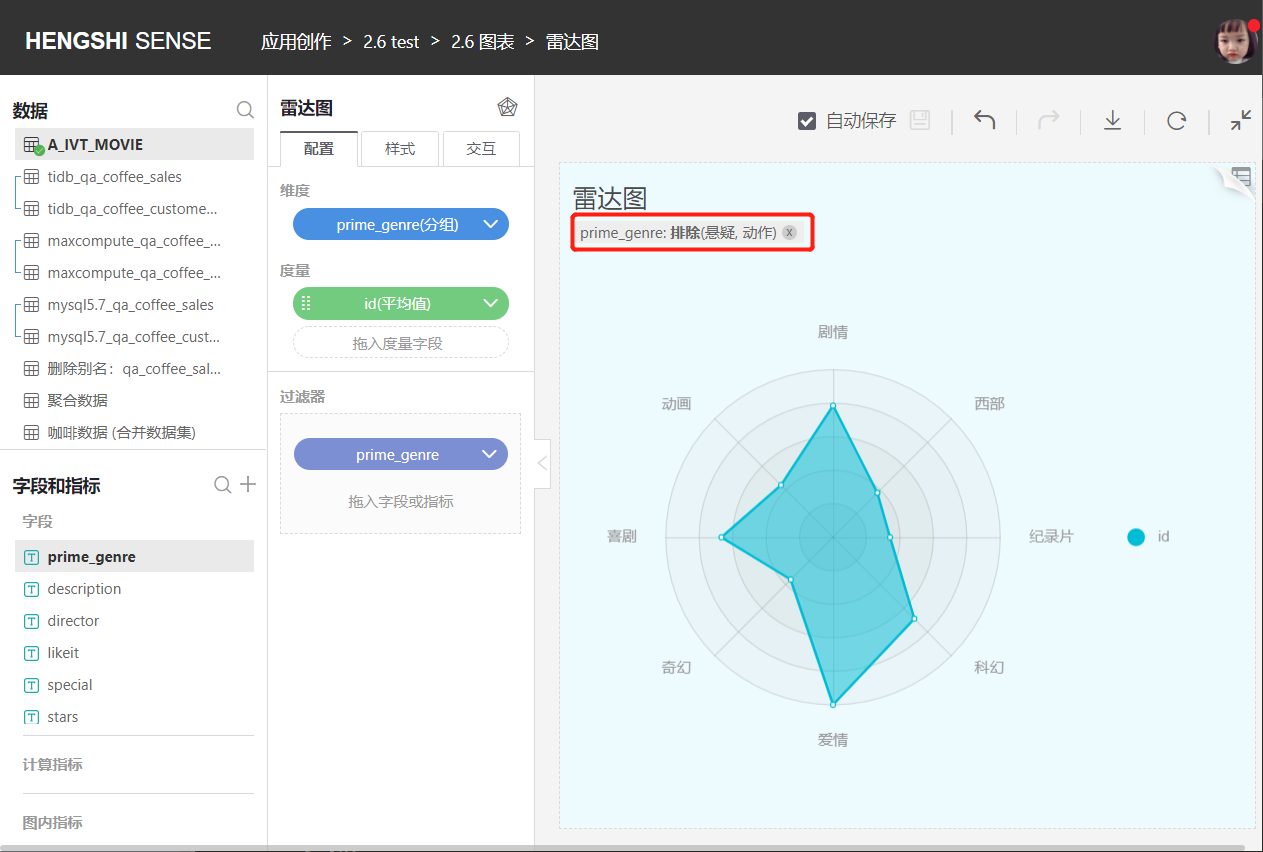
Style
The style includes the following parts:
- Title
- Chart Content
- Shadow
- X-axis
- Y-axis
- Legend
- Reference Line
- Padding
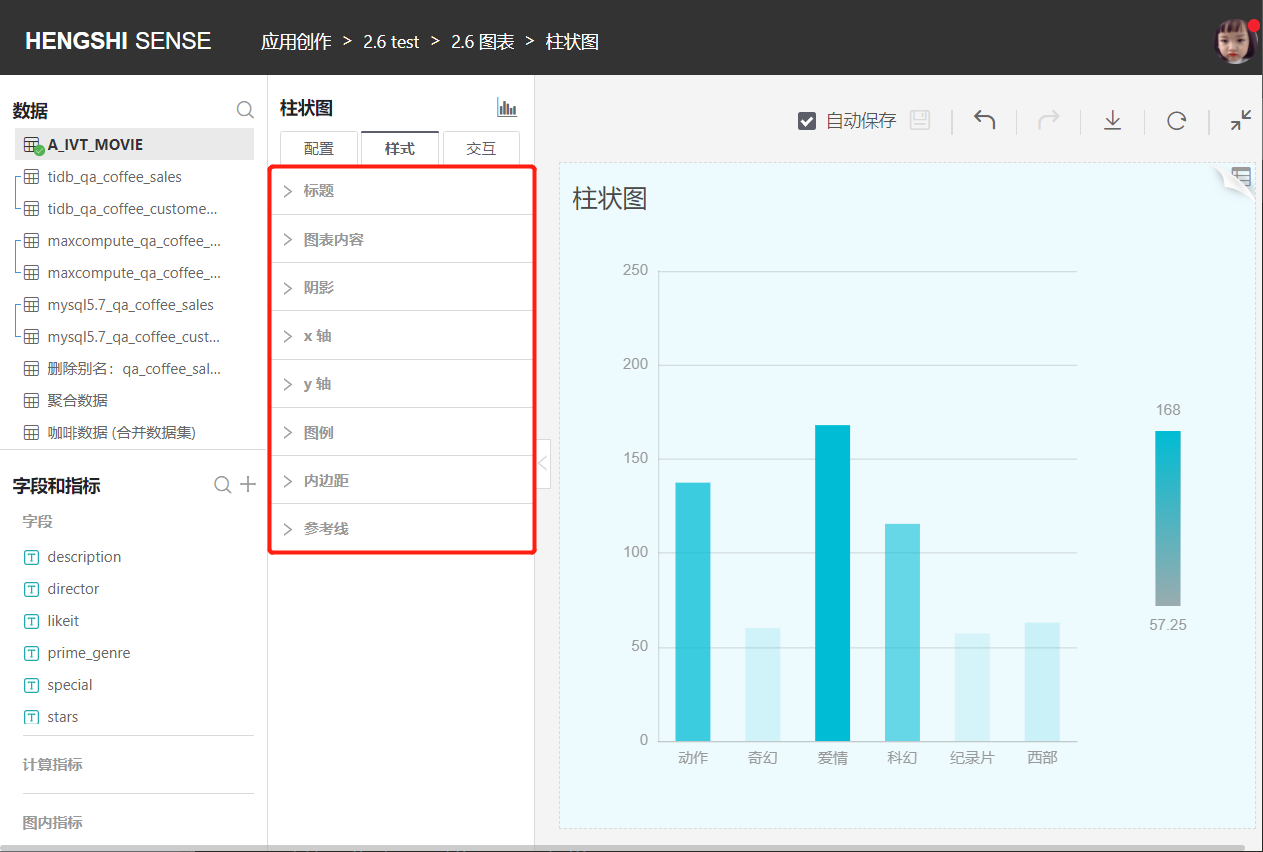
Title
You can customize the name of the chart.
Chart Content
Chart content includes the following parts:
- Color: You can change the chart color scheme. You can choose predefined color schemes from the palette, or customize the color for each dimension group individually.
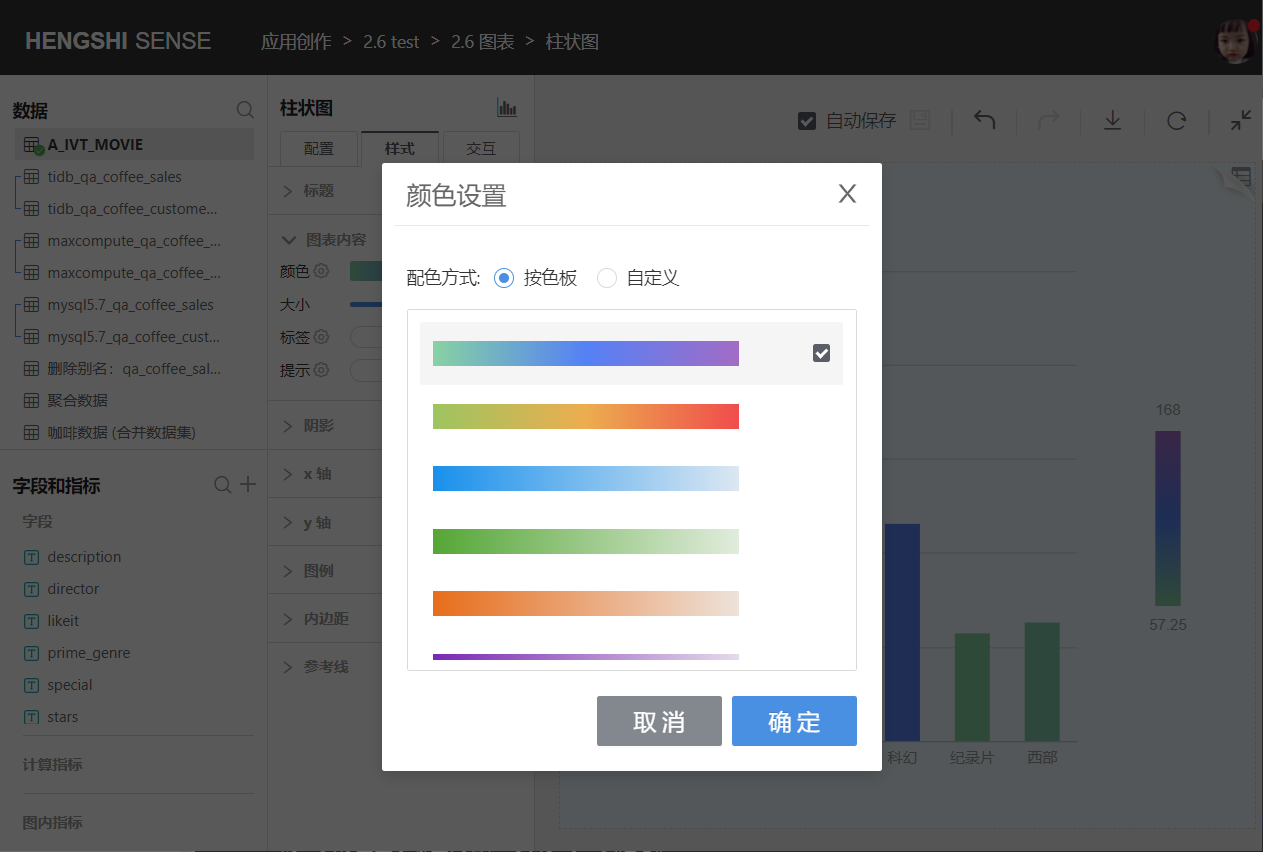
In the color settings, the Show Gradient checkbox is displayed at the bottom, allowing you to set gradients in all non-gradient color schemes for bar charts and area charts. 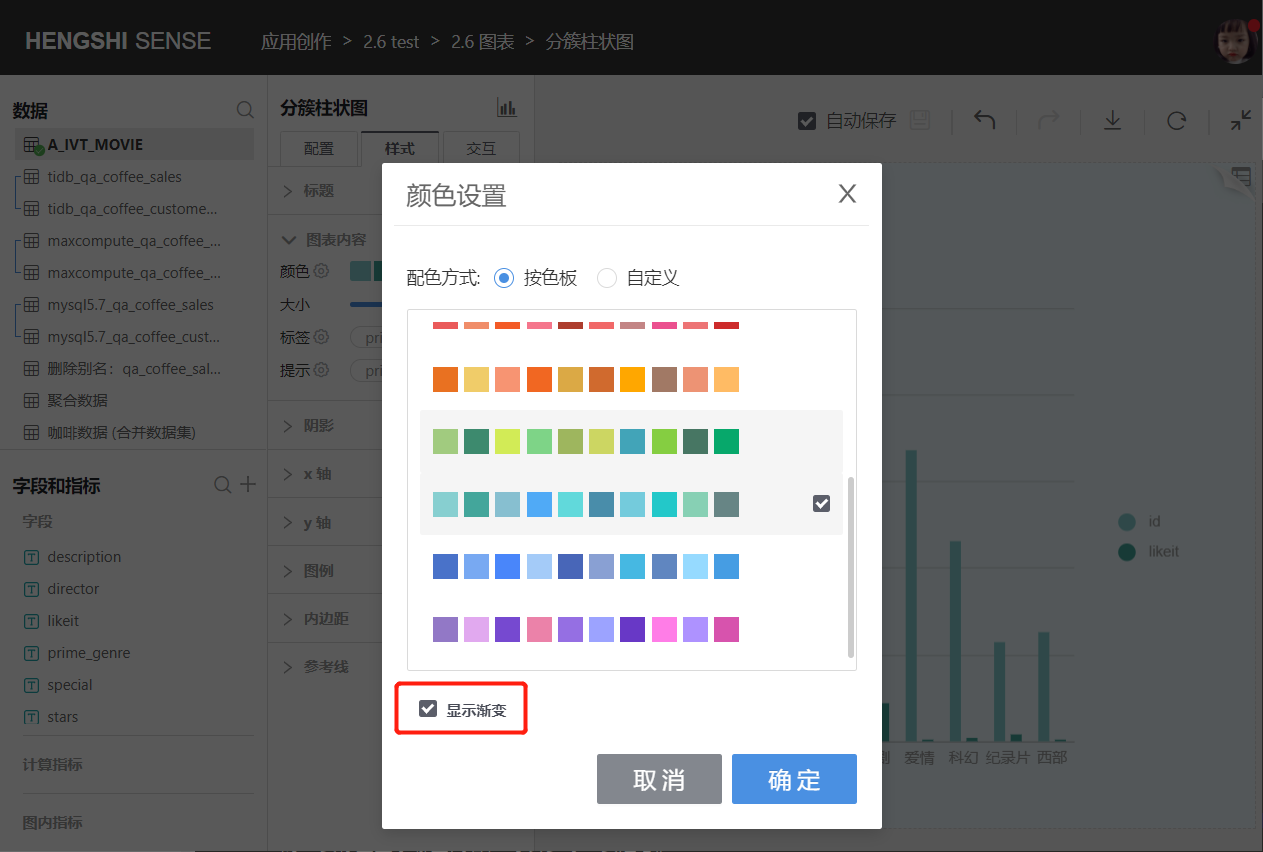
Size: You can adjust the size of the chart.
Labels: Chart labels can display measure values, dimension groups, and other information. You can modify the font, color, weight, text angle, position, and offset of the labels.

Tooltips: Tooltips can display measure values and dimension groups. You can modify the font, color, weight, border color, thickness, shape, and background color of the tooltips.
Shadow
Only charts under the bar chart grouping can set shadows. Click Style -> Shadow to set whether to display the shadow and the color of the shadow. 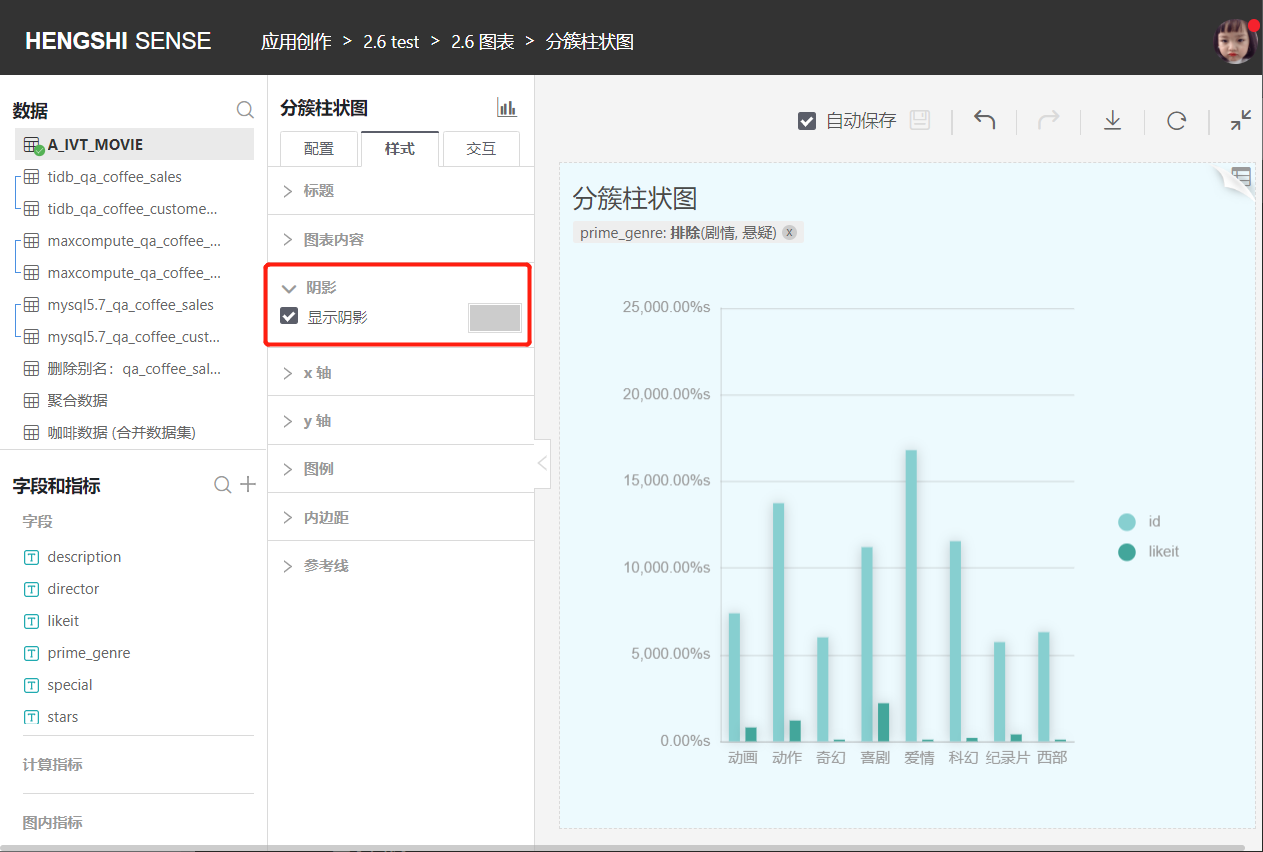
X-axis
You can adjust the font color, size, text angle, axis style, display axis, and tick labels. 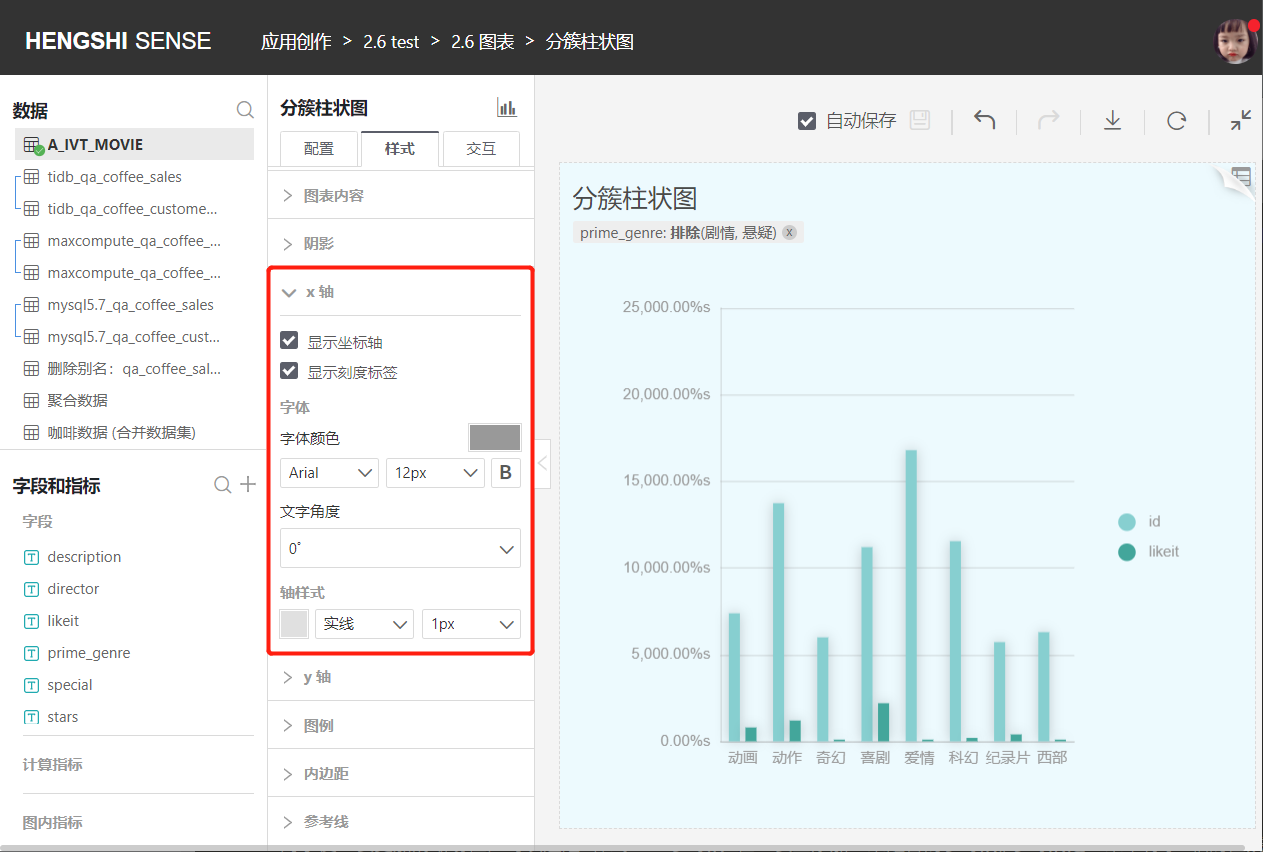
Y-Axis
You can adjust the font color, size, text angle, axis style, display axis, tick labels, adjust the scale range, and tick marks. 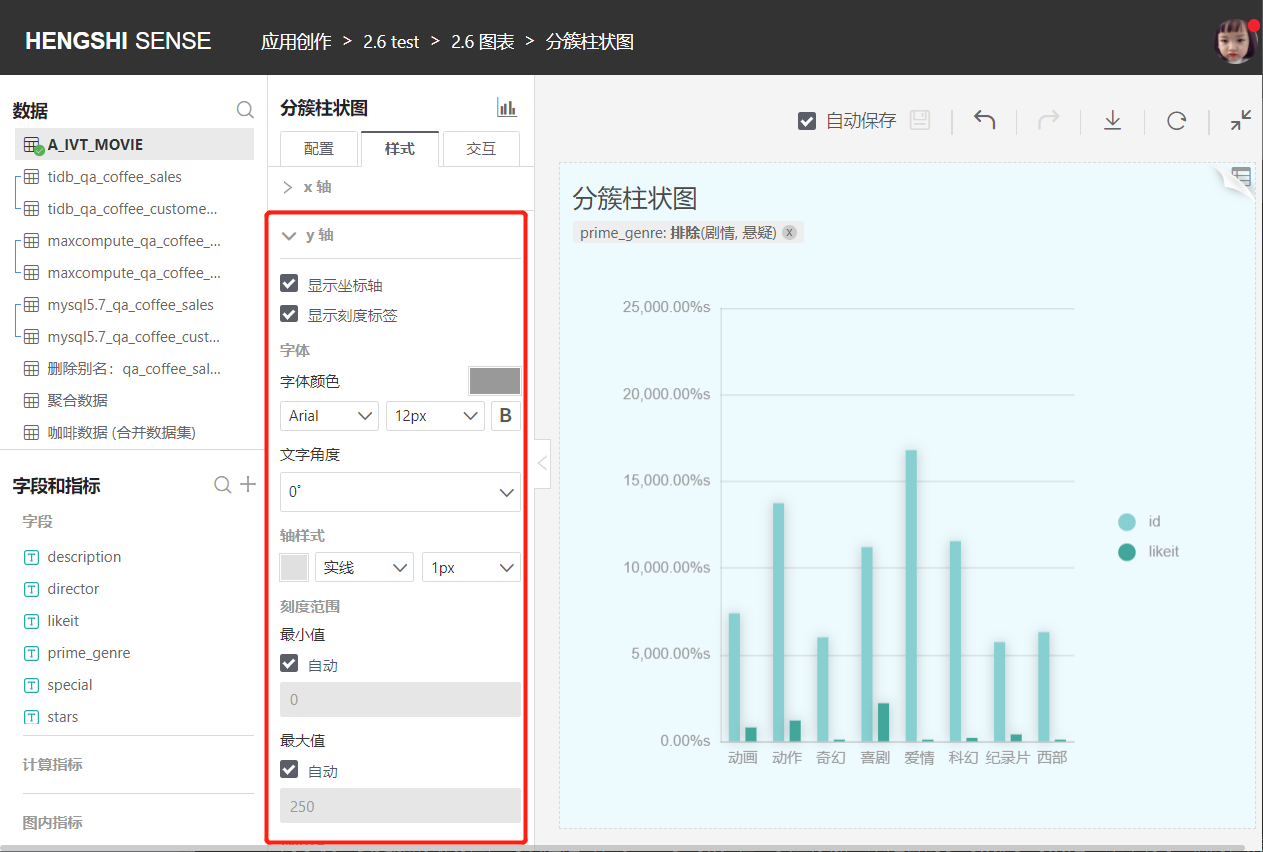
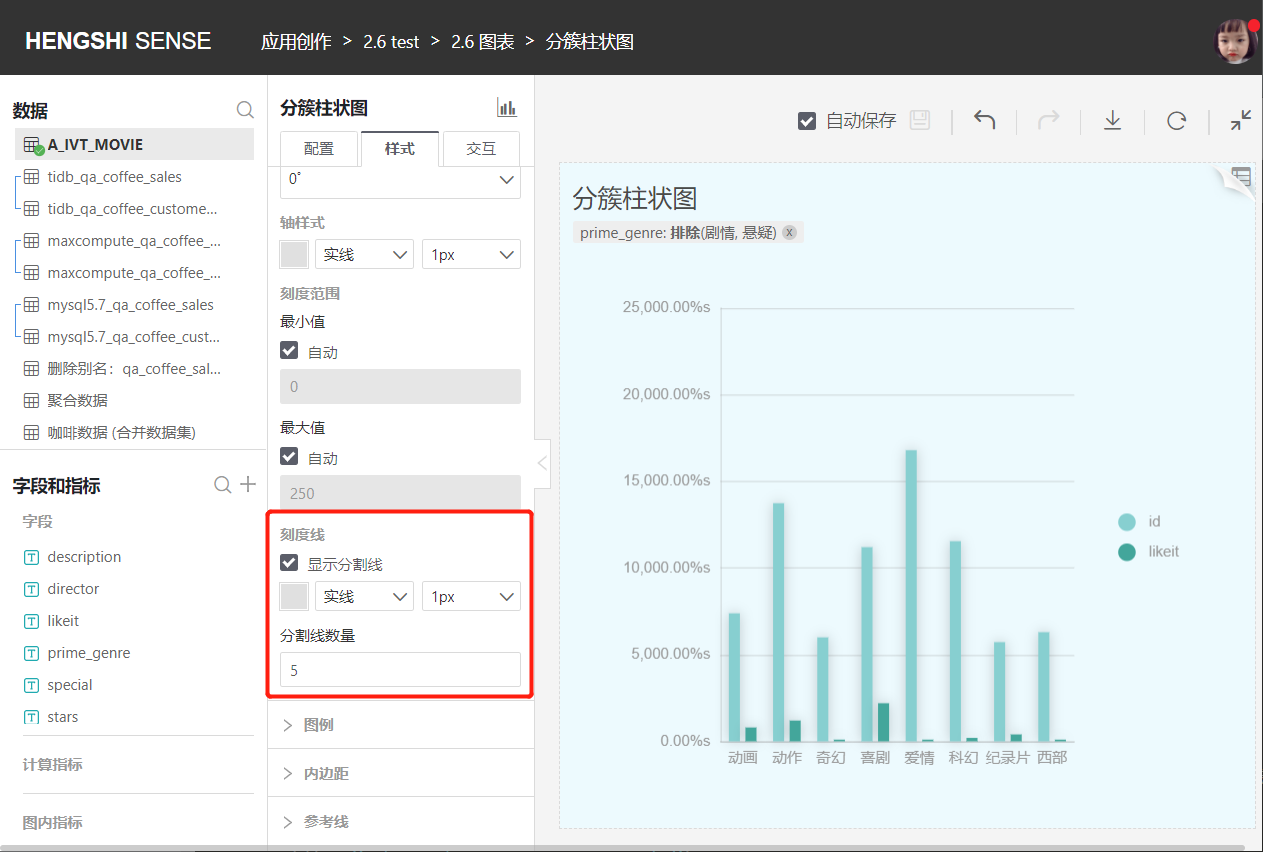
Display Legend
You can set whether to display the legend and its position (left, right, or top) when displayed. You can also modify the legend's font, color, size, and whether it is bold. 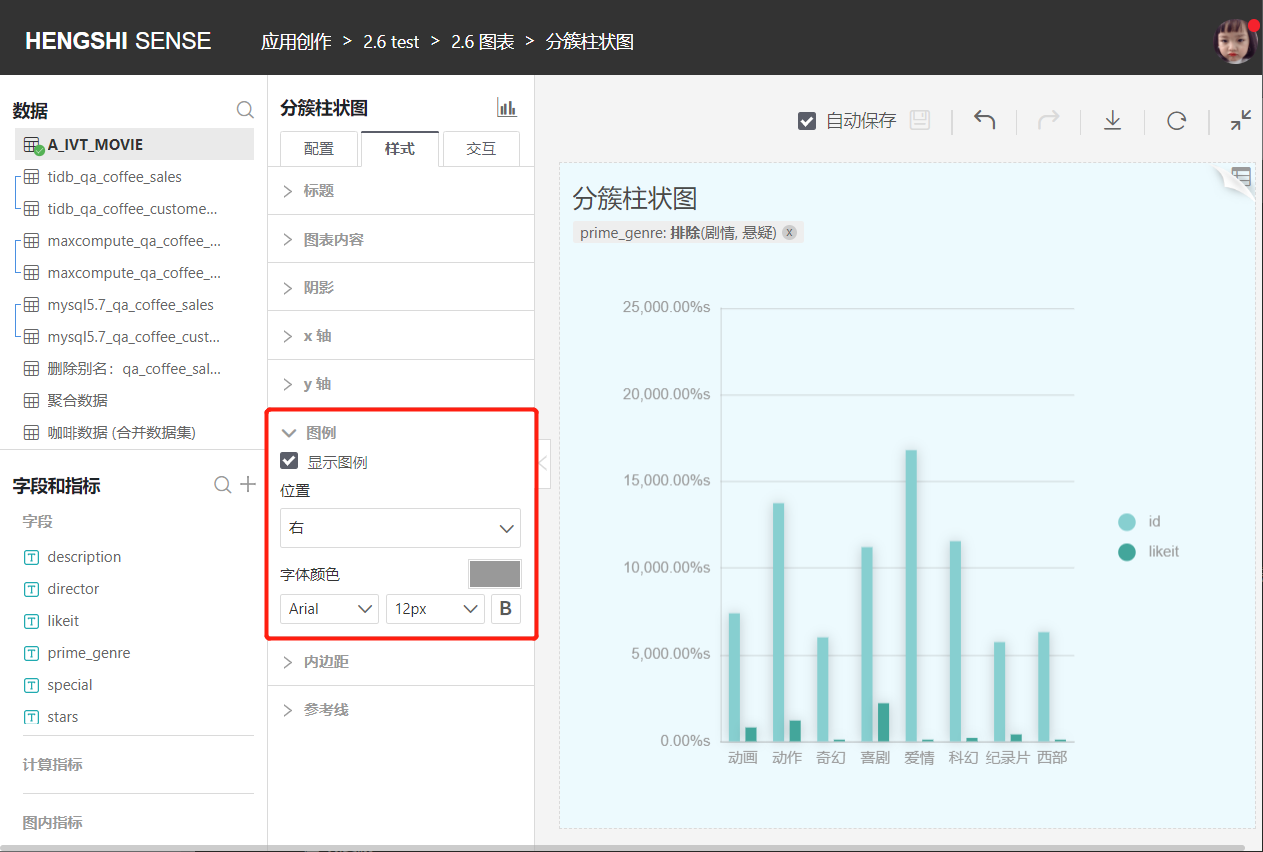
Reference Line
See Reference Line for details.
Padding
Padding can control the position of the chart within the entire page.
Interaction
Interaction includes the following parts:
- Limit Rows
- Auto Refresh
- Value Range Roaming
- Time Range Roaming
- Click Interaction in Charts
- Drill Down Settings
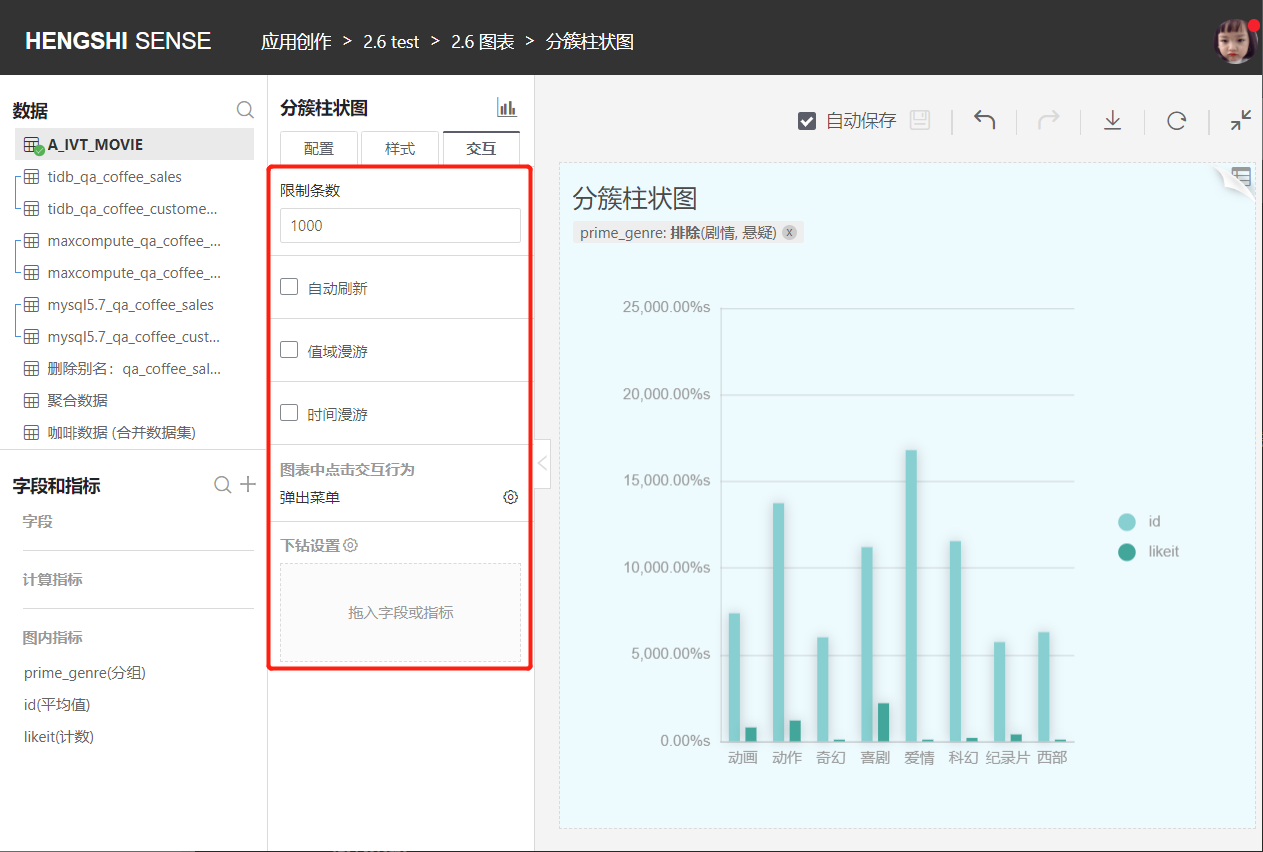
Limit Rows
Users can set the number of rows displayed in the chart by Interaction -> Limit Rows, with a default value of 1000 rows.
Note
Setting this value too high can slow down both the database and the browser.
Auto Refresh
Similar to the Refresh function in dashboards, the auto refresh feature can periodically update chart data automatically. Once the auto refresh feature is enabled, you can set the update interval, and the auto refresh time value supports customization.
Charts with auto refresh set will also automatically refresh in the dashboard. 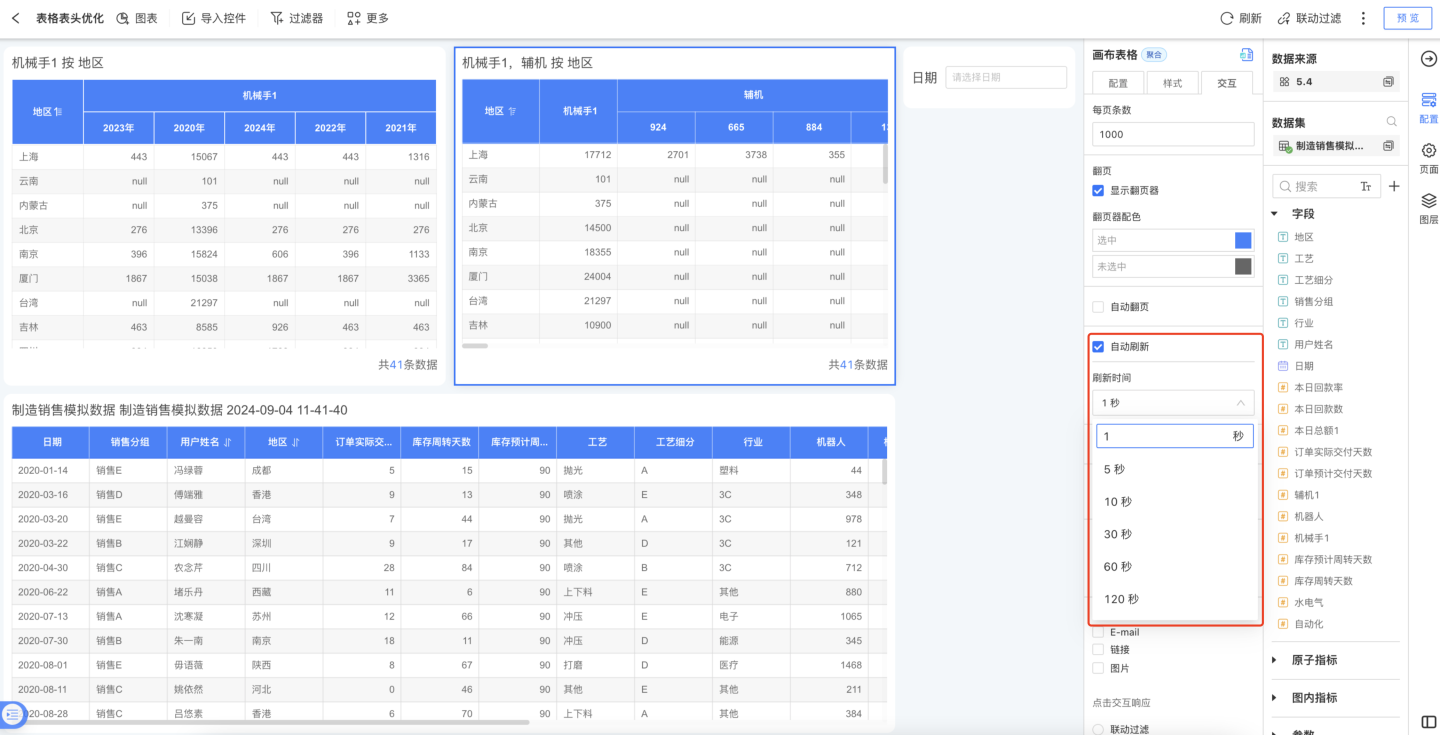
Value Range Roaming
When Value Range Roaming is enabled, a slider will appear on the dimension axis. You can adjust the currently displayed dimensions by sliding the slider, and each dimension will be proportionally redisplayed in the chart. As shown in the figure, the gray scroll bar below the dimension axis: 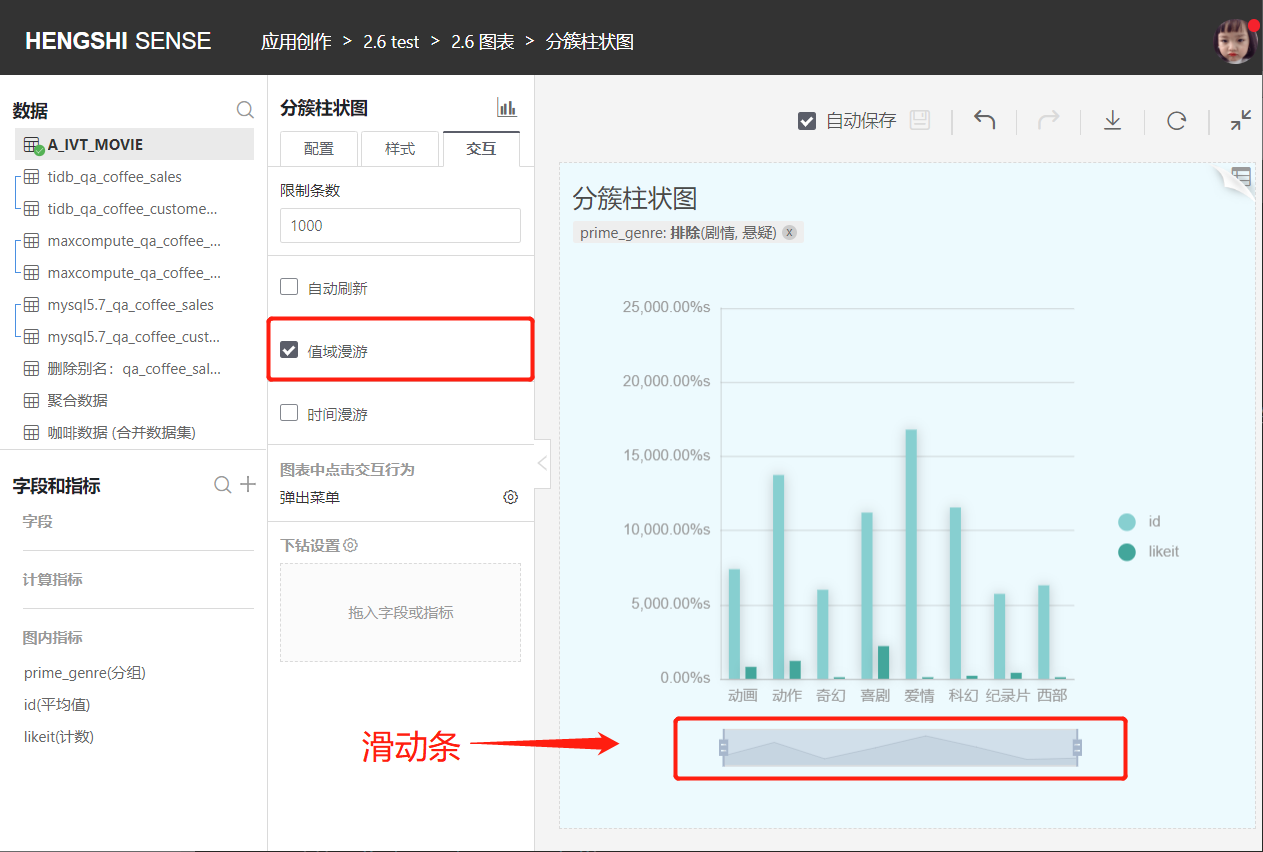
When some chart data has many groups (such as bar charts), but you do not want to display all groups by default, you can configure the default display range for Value Range Roaming (Data Zoom). There are four options available: "All, First M Groups, Last N Groups, Custom", to meet various configuration scenarios. 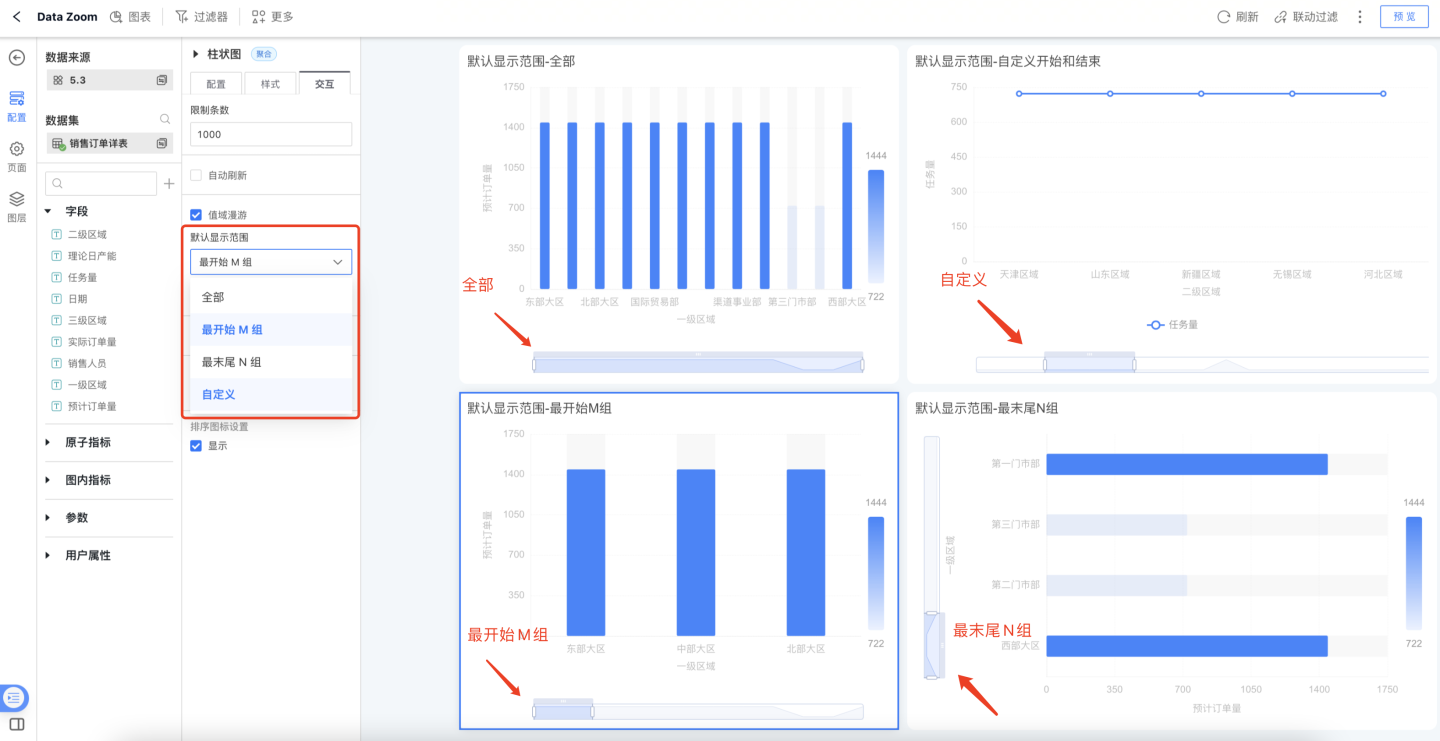
Time Roaming
Enable Show Time Roaming, drag the time field from the field list into the box, and a timeline will be displayed on the chart interface, allowing you to easily drag and view data within different time ranges. The timeline can filter data in three ways:
Drag the timeline to filter data
Select pre-defined time periods to filter data
Choose a time range to filter data
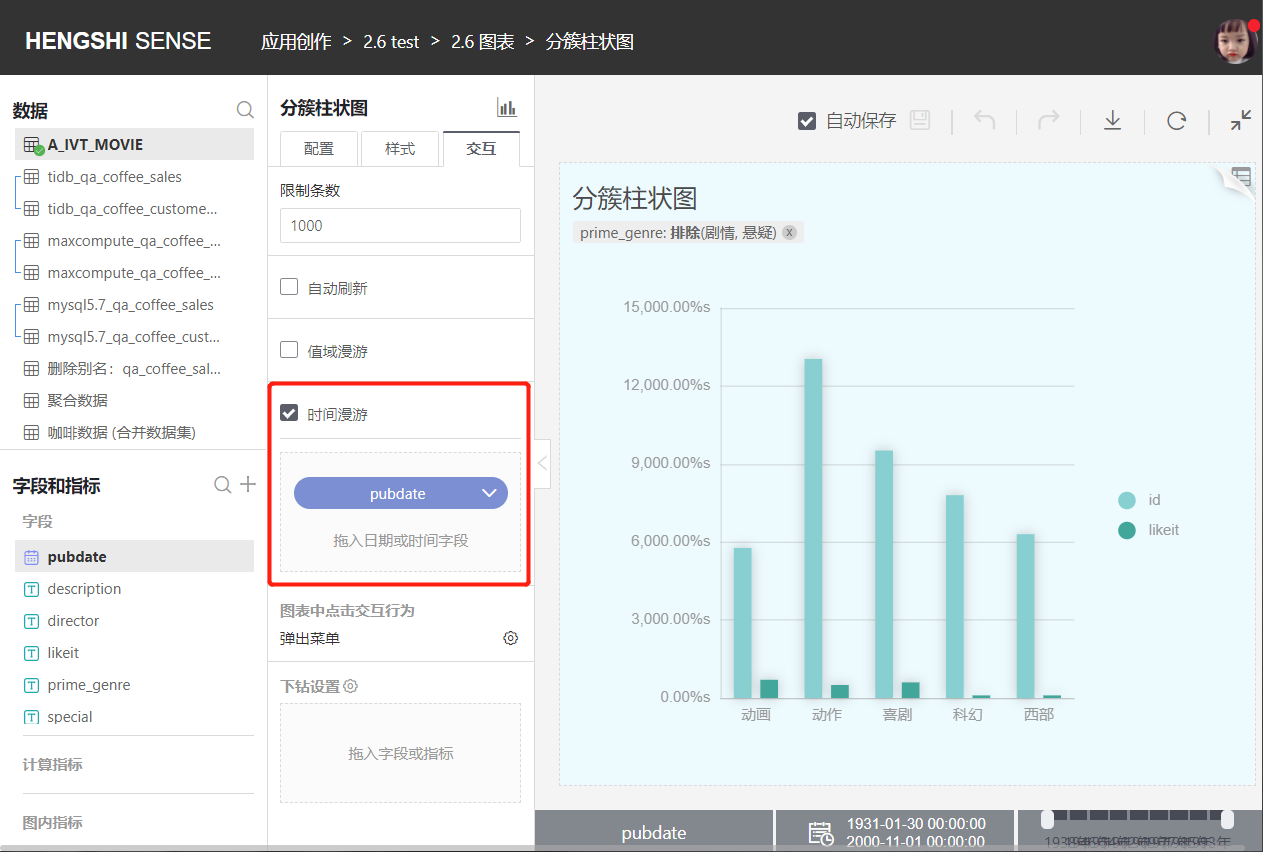
You can set the time range
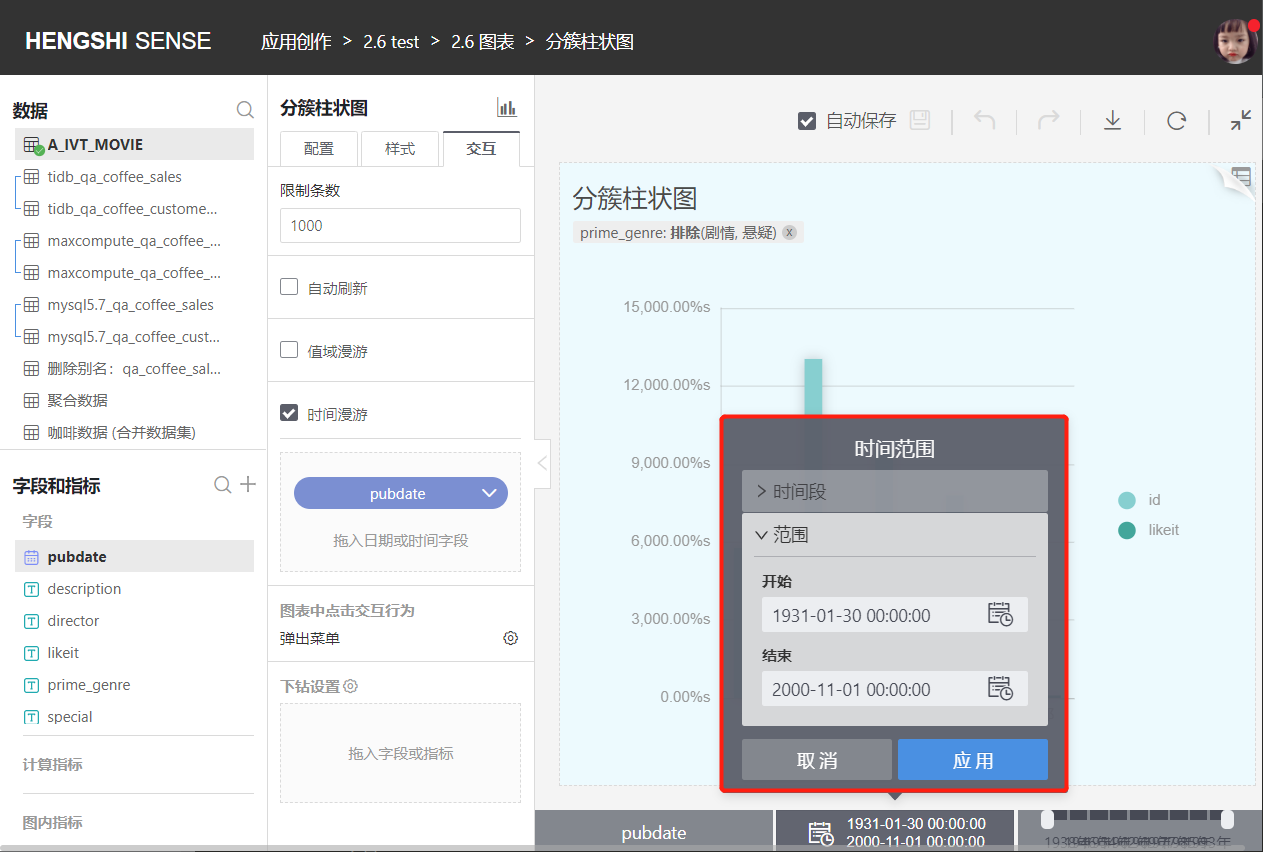
You can drag the timeline to easily change the region
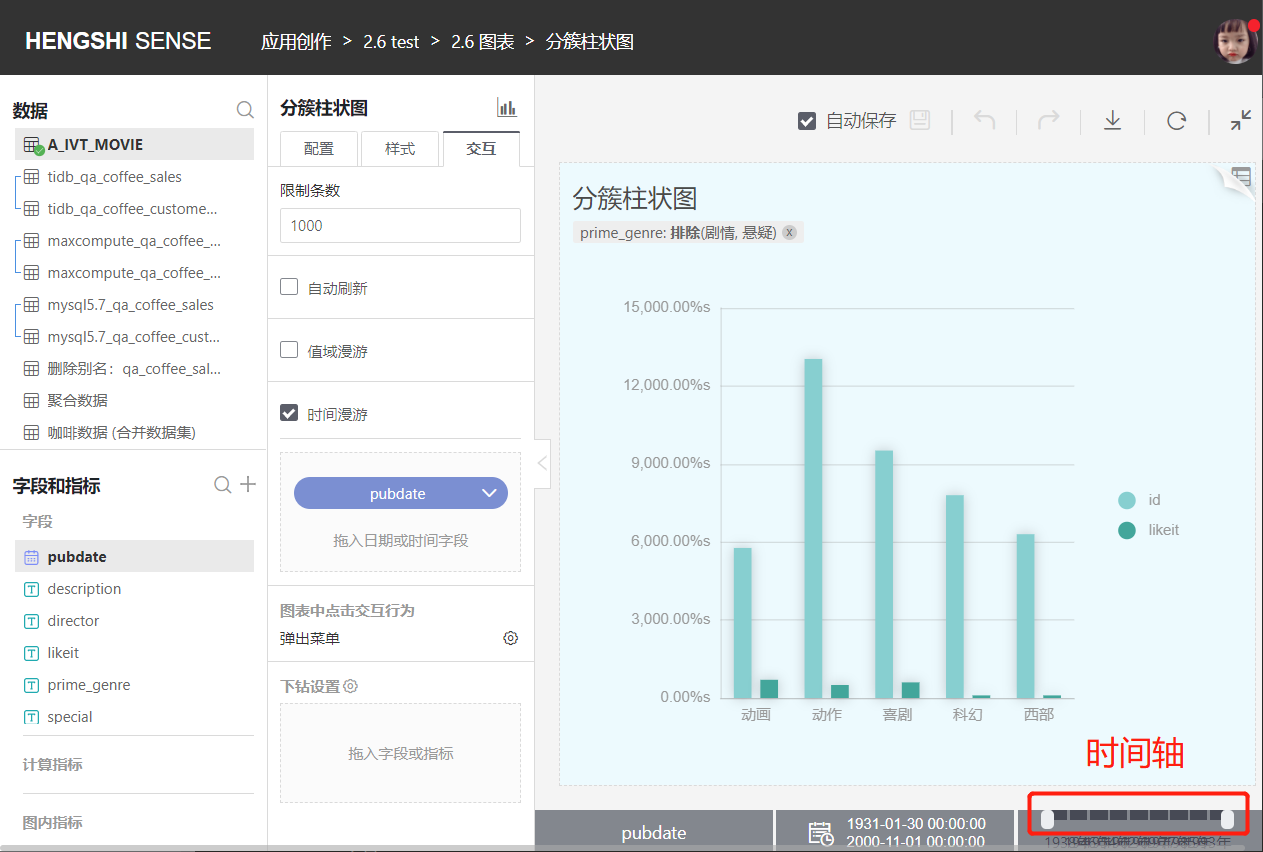
You can select time periods
- All valid time
- This year
- This quarter
- Last 90 days
- This month
- Last 30 days
- This week
- Last 7 days
- Yesterday
- Today
- Current time
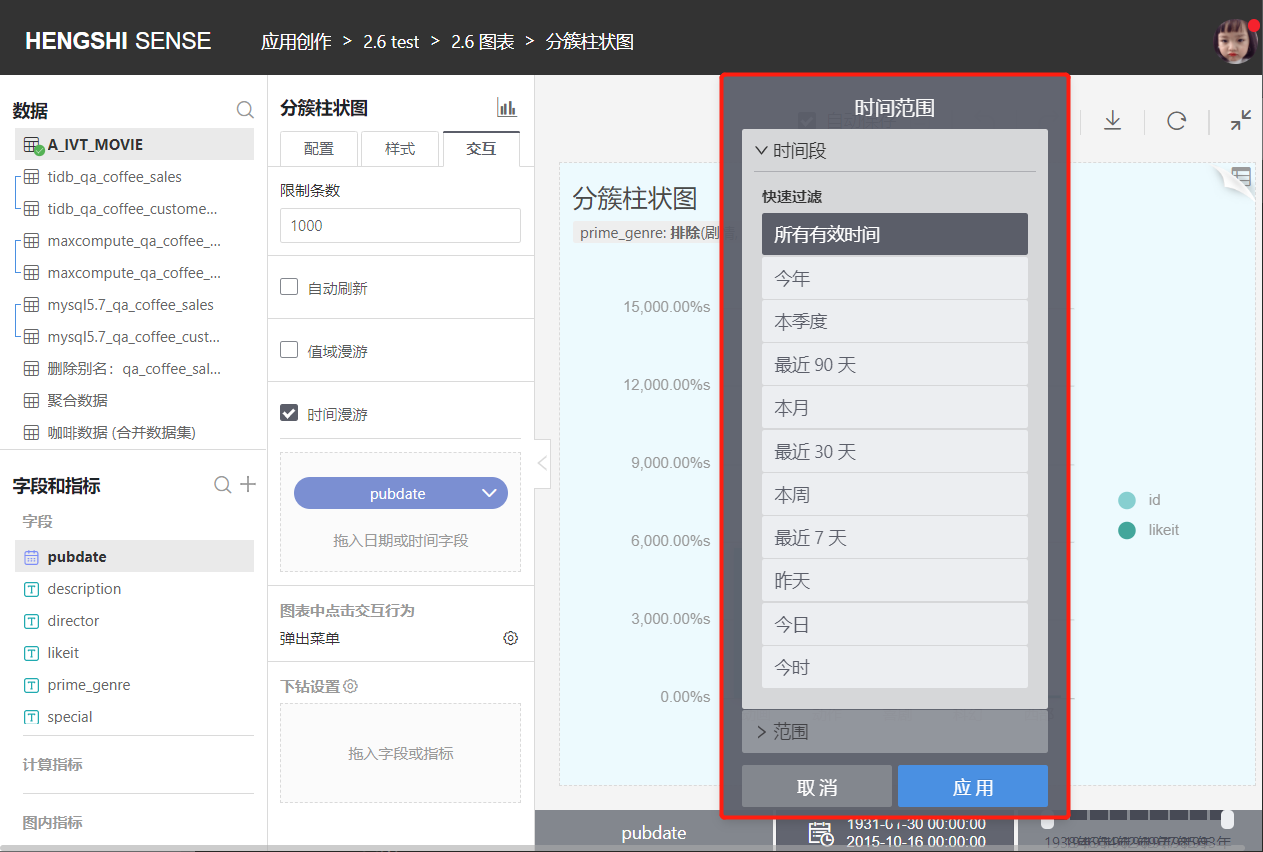
Click Interaction Behavior in Charts
Supports drill-down and exclusion chart types, see Appendix: Summary of Various Charts for details. You can set three display modes for clicking on dimension groups:
- No response
- Pop-up menu
- Drill-down
No Response
Open the chart, click on the chart area and there is no response. 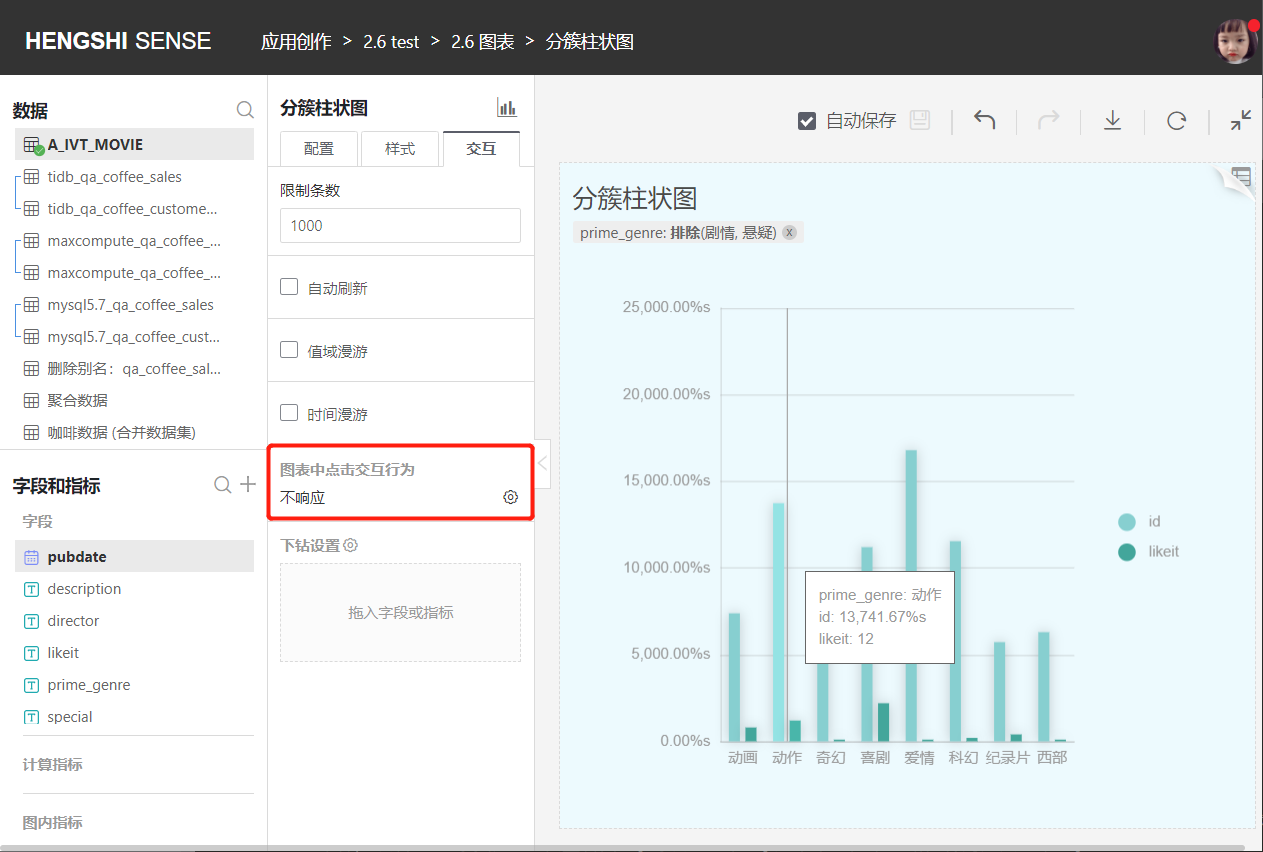
Pop-up Menu
Open the chart, click on the chart area, and there are three operations in the pop-up Tooltip menu: Drill Down, Exclude, and Details. 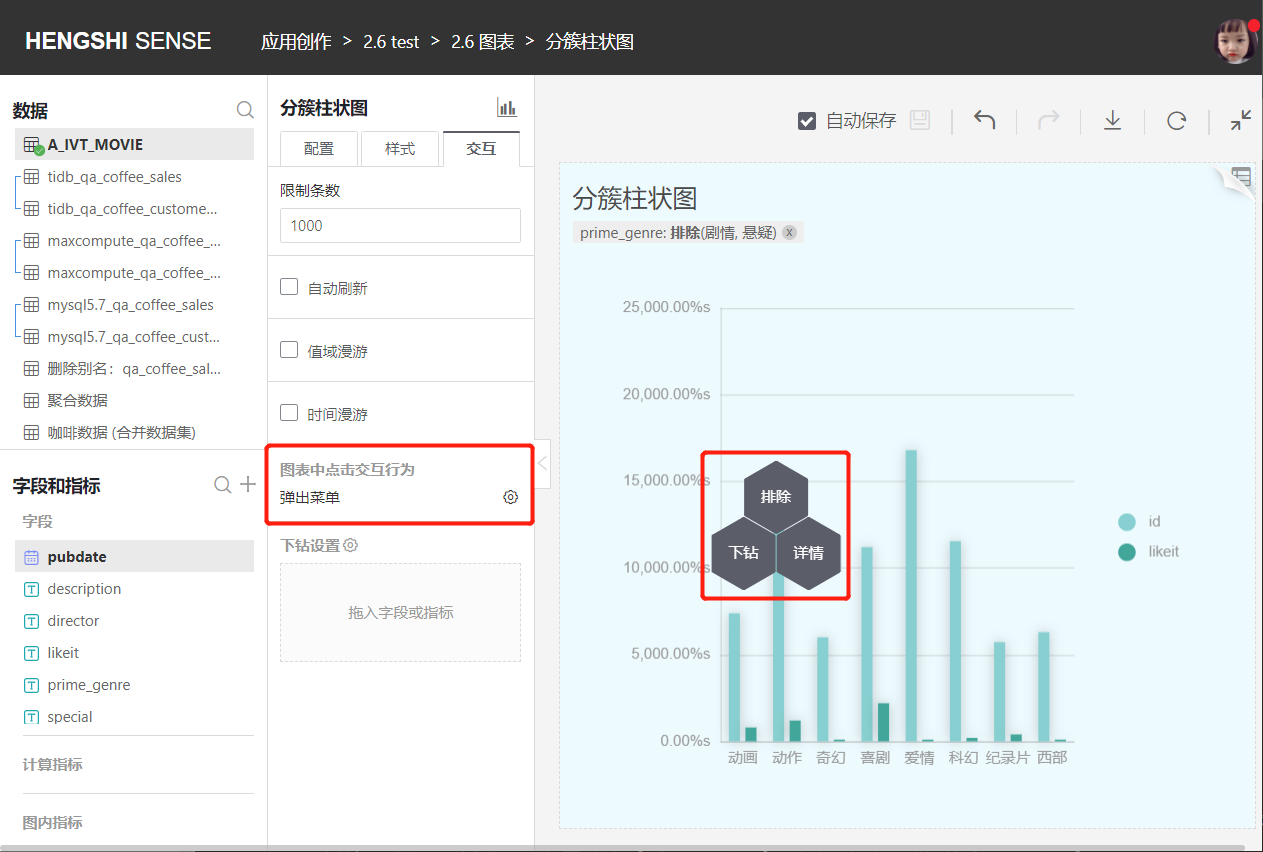
Drill Down
In charts that support drill-down, click on a dimension in the chart, and select Drill Down from the Tooltip that pops up. If a drill-down path is set, the chart will use the selected dimension as a filter condition and redraw the chart with the newly selected field as the dimension. You can drill down continuously. If no drill-down path is set, the drill-down option will not be clickable. 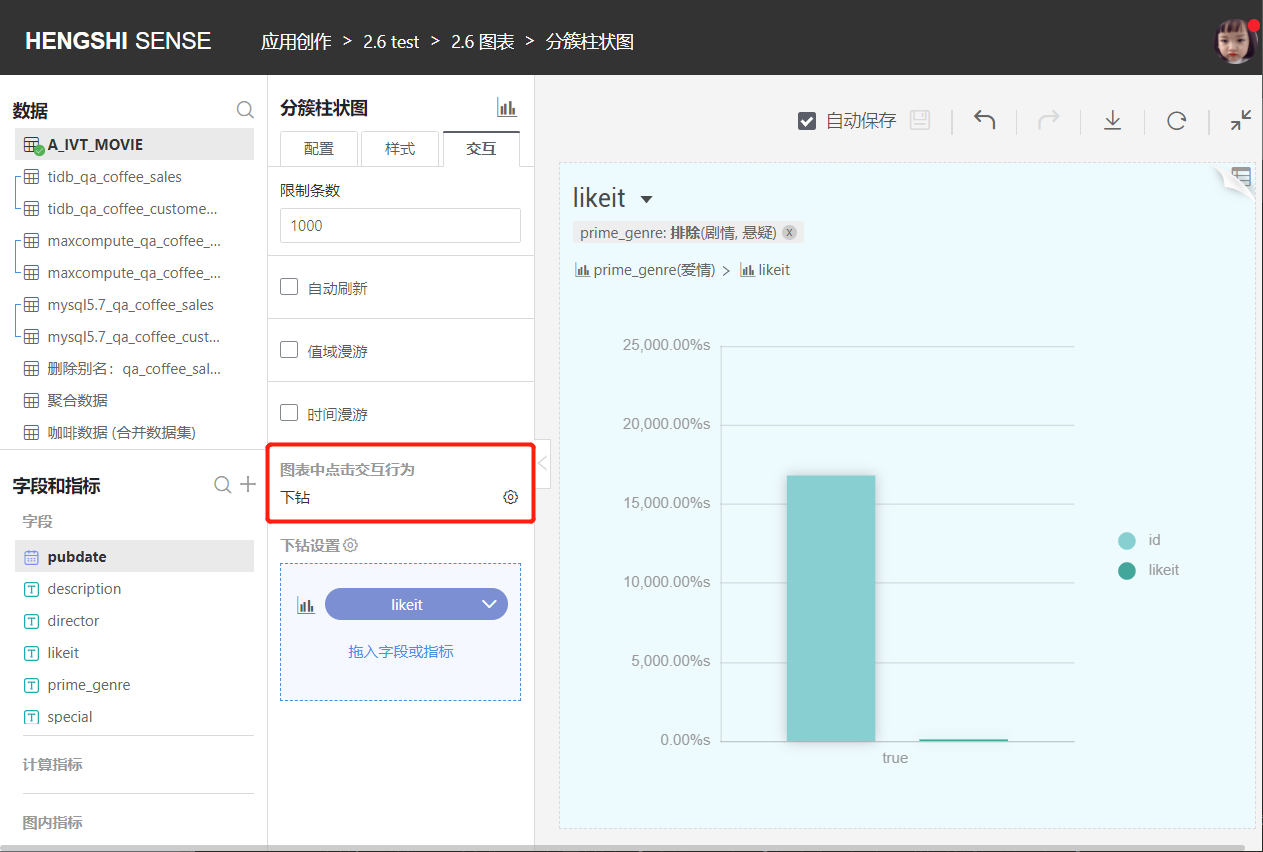
Exclude
Click on a dimension in the chart, and select Exclude in the pop-up Tooltip. The chart will exclude the selected dimension group and retain other dimension groups for plotting. 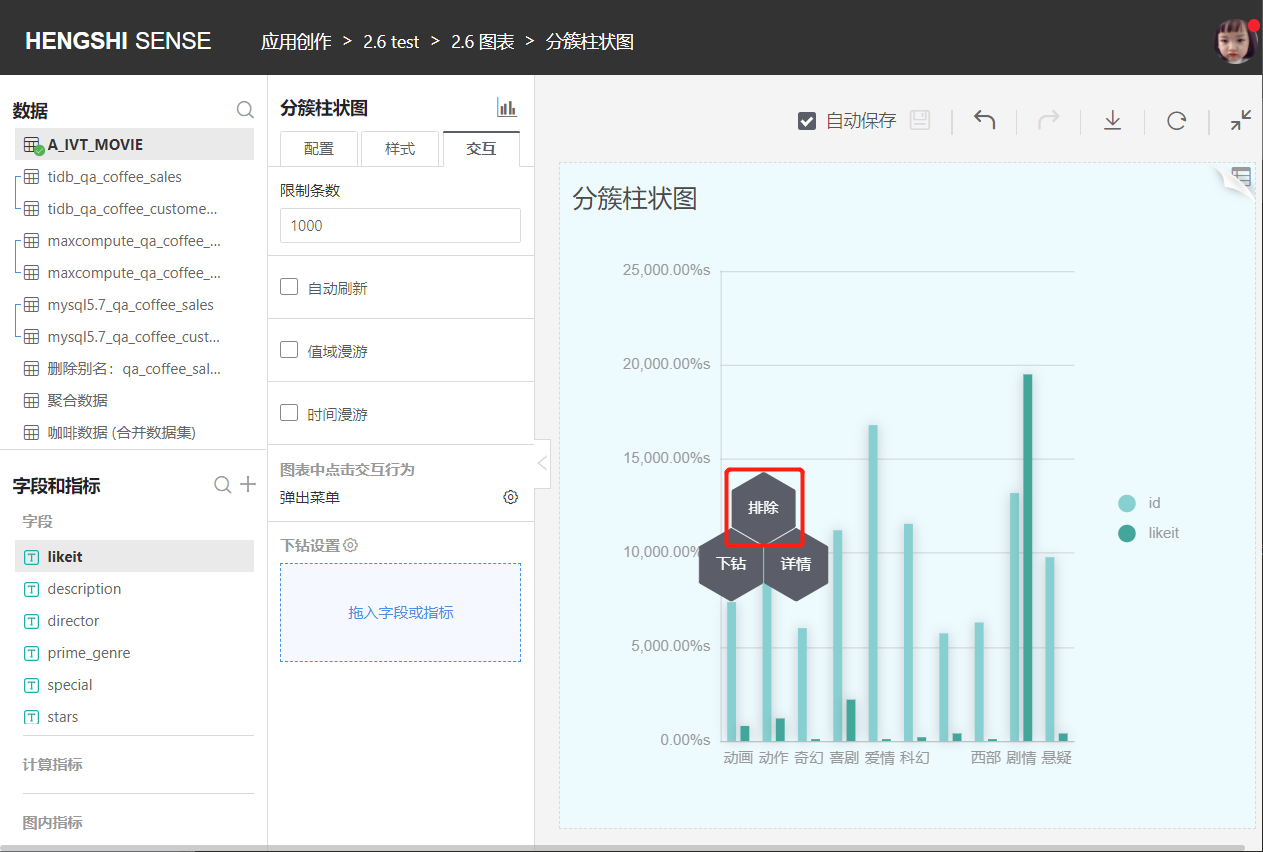
Details
Click on a dimension in the chart, select Details in the pop-up Tooltip, and a new window will display the detailed data of the dimension group. 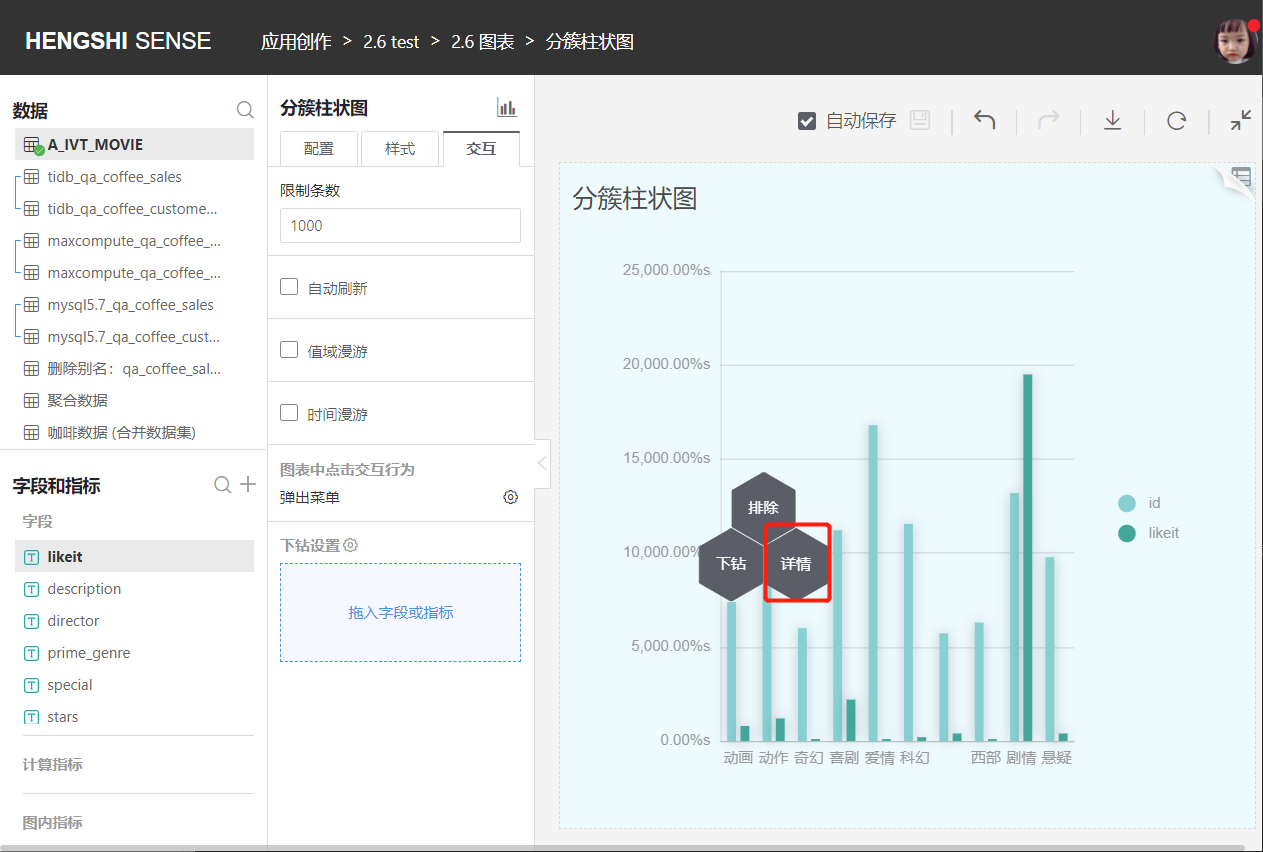
Drill Down
If a drill-down path is set, opening the chart and clicking on the chart area will directly use the selected dimension as a filter condition, and redraw the chart with the newly selected field as the dimension. If no drill-down path is set, there will be no response.
Drill Down Settings
In a chart that supports drill-down, select a field and drag it into Interaction -> Drill Down Settings. Click on a dimension in the chart, and in the Tooltip menu that pops up, click Drill Down. The chart will use the selected dimension as a filter condition and redraw the chart with the newly selected field as the dimension. You can drill down continuously.
Drill-down is a temporary action and does not change the original dimensions of the chart. When we exit the chart and reopen it, the chart will return to its original state.
You can also restore the chart by clicking on the first field in the drill-down path. 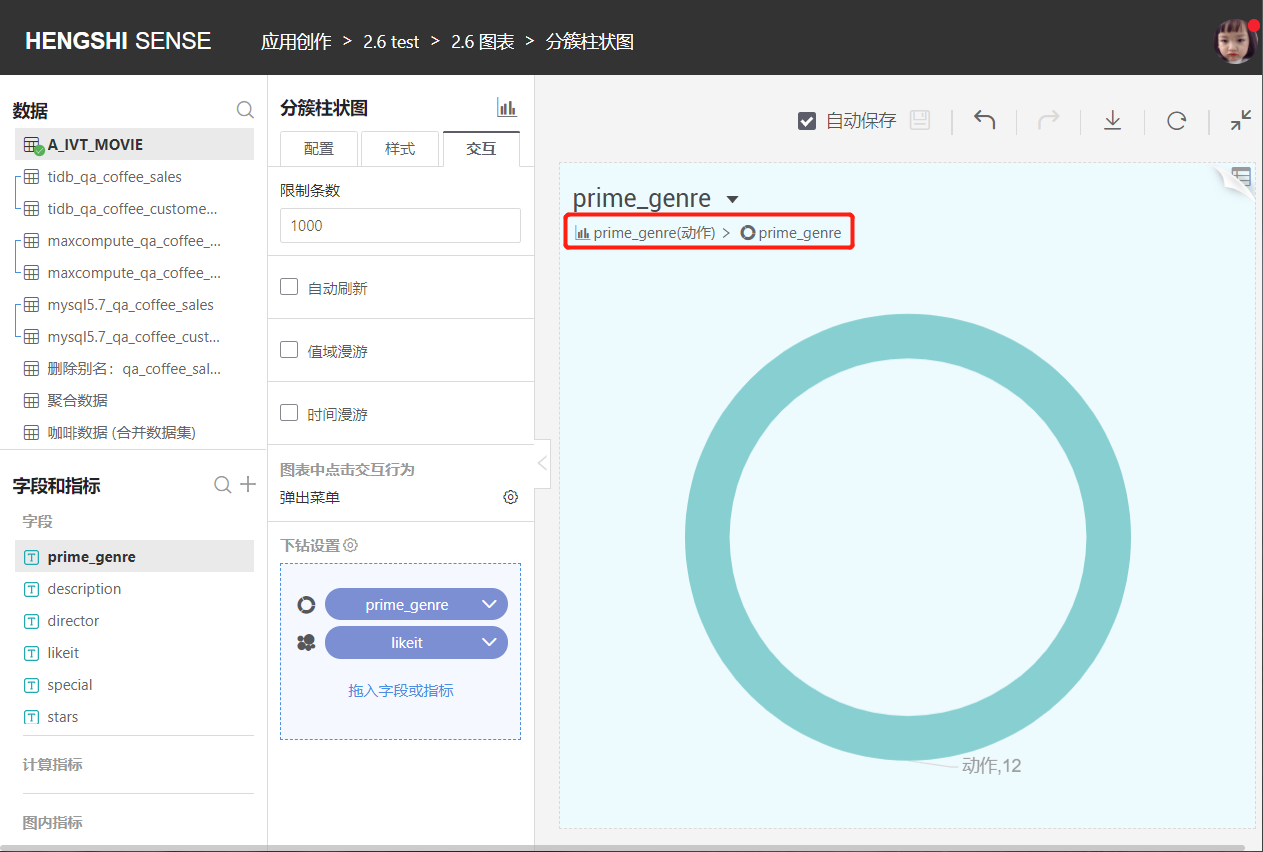
Setting the Chart After Drill Down
Drag the selected field into Interaction -> Drill Down Settings, and click the icon on the left side of the drill path to set the chart type after drilling down. ![]()
Among them, charts with colored icons are selectable, while charts with gray icons are disabled. Hovering the mouse over the icon will display the required number of dimensions and measures for the current chart. 
Setting the Style of the Drill-Down Chart
You can set the style of the drill-down chart, including (title, chart content, legend, and chart padding). The current chart style settings do not affect the style of the parent chart. When you return to the parent chart and drill down again, the chart style will still be the custom style. 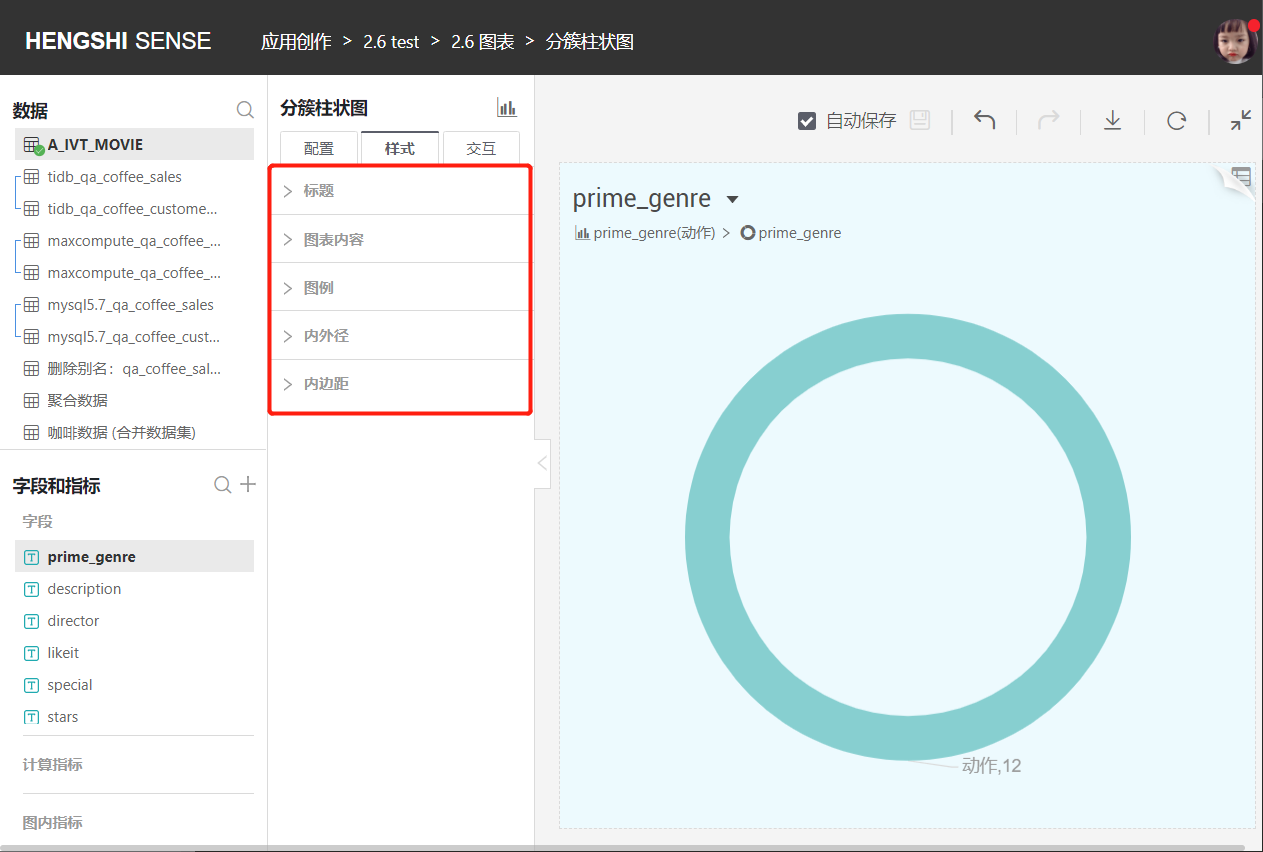
Set/Cancel Drill Path
After dragging the selected field into Interaction -> Drill Settings, the drill path will be automatically saved.
After dragging, when opening the chart, clicking Drill will drill down step by step according to the set path. When reaching the last step, Drill will be disabled.
If you want to continue drilling down, you need to continue dragging fields into the drill settings box. After dragging, you can continue drilling down.
Clicking the leftmost dimension field in the drill path can cancel the drill path. If the drill path is canceled, the chart will automatically update to display the content before drilling down.
Cancel Drill-Down Operation
Changing the dimension field will cancel the current drill-down. However, changing the aggregation method of the date dimension will not cancel the drill-down.
During the drill-down process, clicking Exclude will cancel the drill-down.
Adding filter conditions will not cancel the drill-down, and changing measures will not cancel the drill-down.
Setting the Drill Path and Publishing
After setting the drill path, publish the app, and select Allow Drill during publishing. When opening the published or shared chart link on the Web, if the interaction is set to pop-up menu or drill, clicking on the chart will allow drilling according to the set drill path. If the interaction is set to no response, clicking on the chart will not allow drilling according to the set drill path.
Appendix: Summary of Various Charts
- For each type of chart📈, such as pie charts, line charts, scatter plots, area charts, bar charts, etc., it is generally necessary to configure fields of different dimensions, set sort/limit options, configure filters, etc. The unified summary is as follows:
| Chart Type | Number of Dimensions | Number of Measures | Dimension Sorting | Drill Down | Legend | Legend Interaction | Chart Labels | Linked Filtering | Reference Line | Scale Range Setting | Exclusion |
|---|---|---|---|---|---|---|---|---|---|---|---|
| Bar Chart | 1 | 1 | Data Source/Alphabet/Field/Manual Sorting | Allowed | Default Measure Range | None | Measure Value | Dimension Grouping | Fixed Value/Calculated Value | Allowed | Dimension Grouping |
| Clustered Bar Chart | 1 | 1~N | Data Source/Alphabet/Field/Manual Sorting | Allowed | Each Measure | Single/Multiple Selection | Measure Value | Dimension Grouping | Fixed Value/Calculated Value | Allowed | Dimension Grouping |
| Grouped Clustered Bar Chart | 2 | 1 | Data Source/Alphabet/Field/Manual Sorting | Allowed | Sub-dimension Groups | Single/Multiple Selection | Measure Value | Main Dimension Grouping | Fixed Value/Calculated Value | Allowed | Main Dimension Grouping |
| Grouped Stacked Bar Chart | 2 | 1 | Data Source/Alphabet/Field/Manual Sorting | Allowed | Sub-dimension Groups | Single/Multiple Selection | Measure Value | Main Dimension Grouping | Fixed Value/Calculated Value | Allowed | Main Dimension Grouping |
| Percentage Grouped Stacked Bar Chart | 2 | 1 | Data Source/Alphabet/Field/Manual Sorting | Allowed | Sub-dimension Groups | Single/Multiple Selection | Measure Value | Main Dimension Grouping | Fixed Value/Calculated Value | Allowed | Main Dimension Grouping |
| Horizontal Bar Chart | 1 | 1 | Data Source/Alphabet/Field/Manual Sorting | Allowed | Measure Range | None | Measure Value | Dimension Grouping | Fixed Value/Calculated Value | Allowed | Dimension Grouping |
| Horizontal Clustered Bar Chart | 1 | 1~N | Data Source/Alphabet/Field/Manual Sorting | Allowed | Each Measure | Single/Multiple Selection | Measure Value | Dimension Grouping | Fixed Value/Calculated Value | Allowed | Dimension Grouping |
| Horizontal Stacked Bar Chart | 1 | 1~N | Data Source/Alphabet/Field/Manual Sorting | Allowed | Each Measure | Single/Multiple Selection | Measure Value | Dimension Grouping | Fixed Value/Calculated Value | Allowed | Dimension Grouping |
| Horizontal Percentage Stacked Bar Chart | 1 | 1~N | Data Source/Alphabet/Field/Manual Sorting | Allowed | Each Measure | Single/Multiple Selection | Measure Value | Dimension Grouping | Fixed Value/Calculated Value | Allowed | Dimension Grouping |
| Ring Bar Chart | 1 | 1 | None | Allowed | Dimension Groups | Single/Multiple Selection | Measure Value | Dimension Grouping | Not Supported | Allowed | Dimension Grouping |
| Stacked Bar Chart | 1 | 1~N | Data Source/Alphabet/Field/Manual Sorting | Allowed | Each Measure | Single/Multiple Selection | Measure Value | Dimension Grouping | Fixed Value/Calculated Value | Allowed | Dimension Grouping |
| Percentage Stacked Bar Chart | 1 | 1~N | Data Source/Alphabet/Field/Manual Sorting | Allowed | Each Measure | Single/Multiple Selection | Measure Value | Dimension Grouping | Fixed Value/Calculated Value | Allowed | Dimension Grouping |
| Box Plot | 1 | 1 | Data Source/Alphabet/Field/Manual Sorting | Allowed | Dimension Groups | Single/Multiple Selection | None | Dimension Grouping | None | Allowed | Dimension Grouping |
| Waterfall Chart | 1 | 1 | Data Source/Alphabet/Field/Manual Sorting | Allowed | Increase/Decrease | Single/Multiple Selection | Measure Value | Dimension Grouping | Fixed Value | Not Allowed | Dimension Grouping |
| Word Cloud | 1 | 1 | None | Allowed | Measure Range | None | None | Dimension Grouping | None | Not Allowed | Dimension Grouping |
| Ring Chart | 1 | 1 | Data Source/Alphabet/Field/Manual Sorting | Allowed | Dimension Groups | Single/Multiple Selection | Dimension Group Percentage | Dimension Grouping | None | Not Allowed | Dimension Grouping |
| Funnel Chart | 1 | 1 | Data Source/Alphabet/Field/Manual Sorting | Allowed | Dimension Groups | Single/Multiple Selection | Dimension Group/Measure Value/Conversion Rate Between Groups | Dimension Grouping | None | Not Allowed | Dimension Grouping |
| Bubble Chart | 1~N | 1 | None | Allowed | Measure Range | None | Dimension Group/Group Percentage | Combination of Dimension Groups | None | Not Allowed | Combination of Dimension Groups |
| Pie Chart | 1 | 1 | Data Source/Alphabet/Field/Manual Sorting | Allowed | Dimension Groups | Single/Multiple Selection | Dimension Group Percentage | Dimension Grouping | None | Not Allowed | Dimension Grouping |
| Nightingale Chart | 1 | 1 | Data Source/Alphabet/Field/Manual Sorting | Allowed | Dimension Groups | Single/Multiple Selection | Dimension Group Percentage | Dimension Grouping | None | Not Allowed | Dimension Grouping |
| Sunburst Chart | 1~N | 1 | None | Allowed | None | Single/Multiple Selection | Dimension Groups | Combination of Dimension Groups | None | Not Allowed | Combination of Dimension Groups |
| Treemap | 1~N | 1 | None | Allowed | Measure Range | None | Dimension Group | Combination of Dimension Groups | None | Not Allowed | Combination of Dimension Groups |
| Area Chart | 1 | 1~N | Data Source/Alphabet/Field/Manual Sorting | Allowed | Each Measure | Single/Multiple Selection | Measure Value | Dimension Grouping | Fixed Value/Calculated Value | Allowed | Dimension Grouping |
| Grouped Area Chart | 2 | 1 | Data Source/Alphabet/Field/Manual Sorting | Allowed | Sub-dimension Groups | Single/Multiple Selection | None | Main Dimension Grouping | Fixed Value/Calculated Value | Allowed | Main Dimension Grouping |
| Grouped Stacked Area Chart | 2 | 1 | Data Source/Alphabet/Field/Manual Sorting | Allowed | Sub-dimension Groups | Single/Multiple Selection | Measure Value | Main Dimension Grouping | Fixed Value/Calculated Value | Allowed | Main Dimension Grouping |
| Percentage Grouped Stacked Area Chart | 2 | 1 | Data Source/Alphabet/Field/Manual Sorting | Allowed | Sub-dimension Groups | Single/Multiple Selection | Measure Value | Main Dimension Grouping | Fixed Value/Calculated Value | Allowed | Main Dimension Grouping |
| Stacked Area Chart | 1 | 1~N | Data Source/Alphabet/Field/Manual Sorting | Allowed | Each Measure | Single/Multiple Selection | None | Dimension Grouping | Fixed Value | Not Allowed | Dimension Grouping |
| Percentage Stacked Area Chart | 1 | 1~N | Data Source/Alphabet/Field/Manual Sorting | Allowed | Each Measure | Single/Multiple Selection | None | Dimension Grouping | Fixed Value | Not Allowed | Dimension Grouping |
| Line Chart | 1 | 1~N | Data Source/Alphabet/Field/Manual Sorting | Allowed | Each Measure | Single/Multiple Selection | Measure Value | Dimension Grouping | Fixed Value/Calculated Value | Allowed | Dimension Grouping |
| Line-Bar Combination Chart | 1 | 1~N | Data Source/Alphabet/Field/Manual Sorting | Allowed | Each Measure | Single/Multiple Selection | Measure Value | Dimension Grouping | Fixed Value/Calculated Value | Allowed | Dimension Grouping |
| Grouped Line Chart | 2 | 1 | Data Source/Alphabet/Field/Manual Sorting | Allowed | Sub-dimension Groups | Single/Multiple Selection | Measure Value | Main Dimension Grouping | Fixed Value/Calculated Value | Allowed | Main Dimension Grouping |
| Pareto Chart | 1 | 1 | None | Allowed | Frequency/Cumulative Frequency | Single/Multiple Selection | Measure Value | Dimension Grouping | Fixed Value/Calculated Value | Not Allowed | Dimension Grouping |
| Arc Diagram | 2 | 0 | Data Source/Alphabet/Field/Manual Sorting | Allowed | Sub-dimension Groups | None | None | None | None | Not Allowed | None |
| Chord Diagram | 2 | 1 | Data Source/Alphabet/Field/Manual Sorting | Allowed | Dimension Groups | Hover Only | Dimension Groups | None | None | Not Allowed | None |
| Heatmap | 2 | 1 | Data Source/Alphabet/Field/Manual Sorting | Allowed | Measure Range | None | Measure Value | Combination of Dimension Groups | None | Not Allowed | Combination of Dimension Groups |
| Radar Chart | 1 | 1~N | Data Source/Alphabet/Field/Manual Sorting | Allowed | Each Measure | Single/Multiple Selection | Dimension Group/Measure Value | Dimension Grouping | None | Allowed | None |
| Sankey Diagram | 1~N | 1 | Data Source/Alphabet/Field/Manual Sorting | Allowed | None | None | Dimension Groups | None | None | Not Allowed | None |
| Scatter Plot | 1 | 3 | None | Allowed | Size Measure Range | None | Dimension Groups | Dimension Grouping | Fixed Value/Calculated Value | Allowed to Set, Not Allowed to Merge | Dimension Grouping |
| Dashboard | 0 | 2 | None | Not Allowed | None | None | Percentage Measure Name/Number/Percentage | None | Fixed Value | Not Allowed | None |
| KPI | 0 | 1~N | None | Not Allowed | None | None | None | None | None | Not Allowed | None |
| Metric Trend Card | 1 | 1~N | None | Not Allowed | None | None | None | None | None | Not Allowed | None |
| Table | 0~N | 0~N | Data Source/Alphabet/Field/Manual Sorting | Not Allowed | None | None | None | None | None | Not Allowed | None |